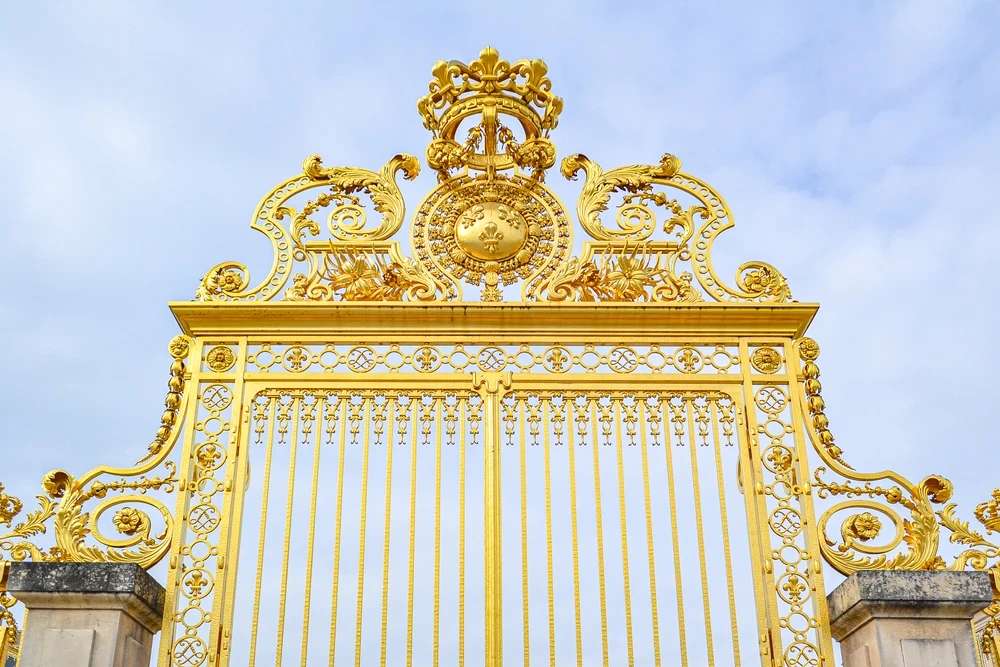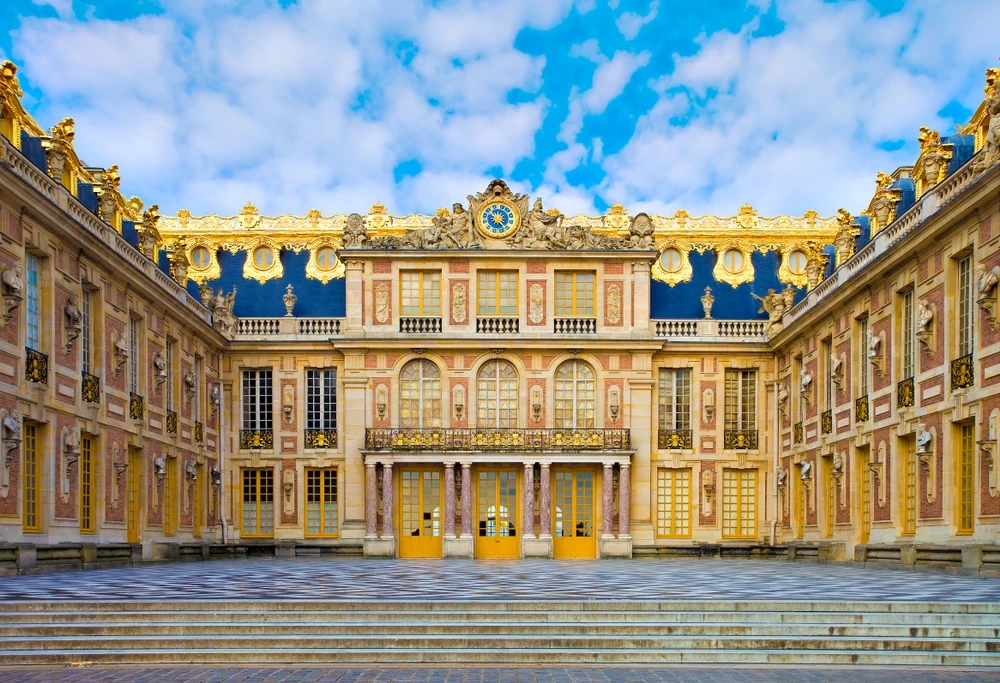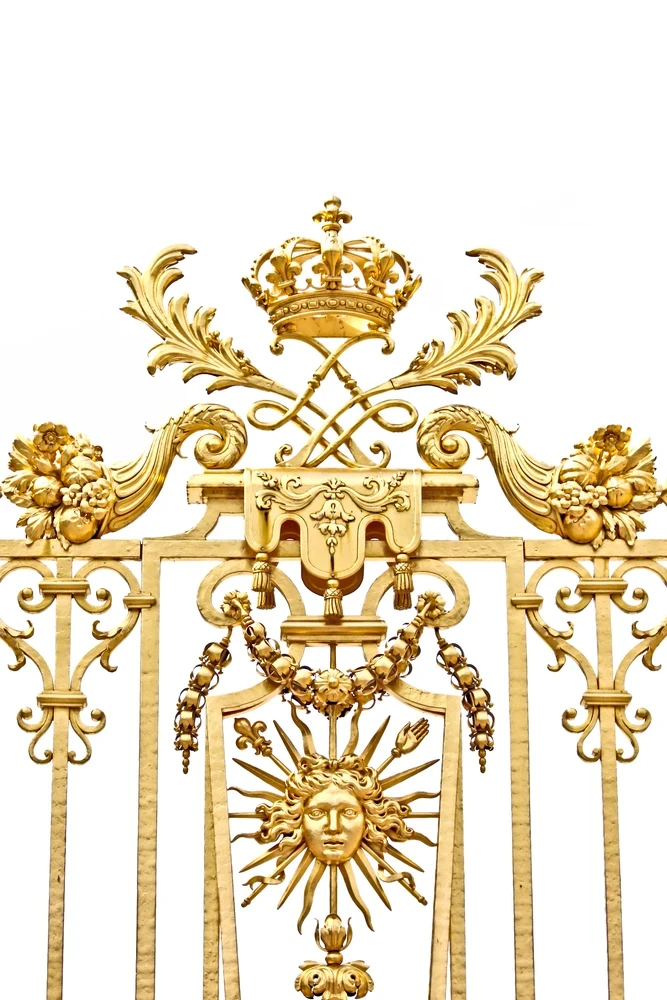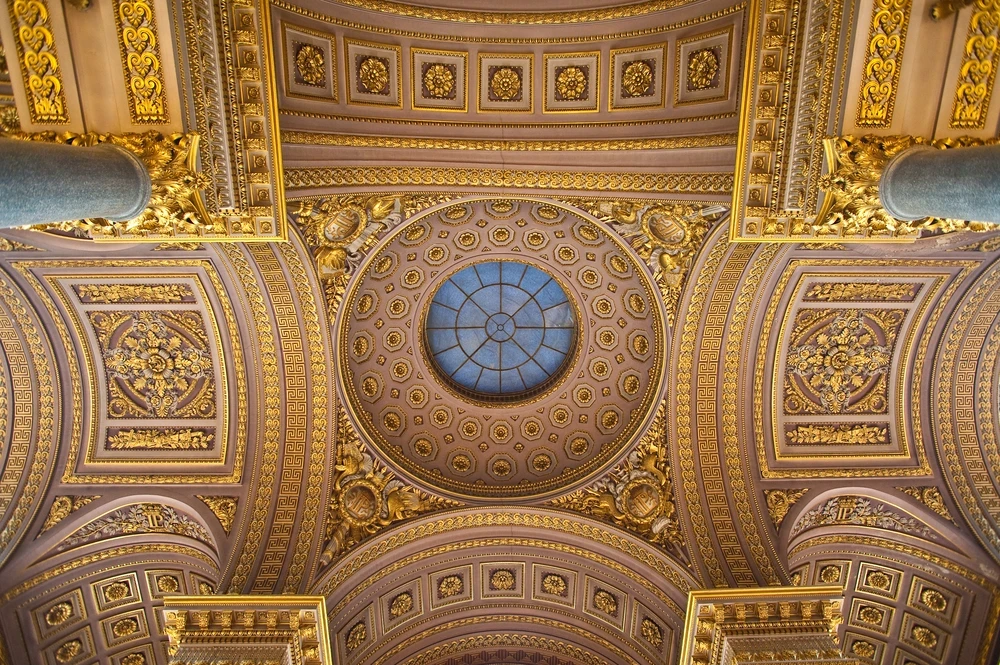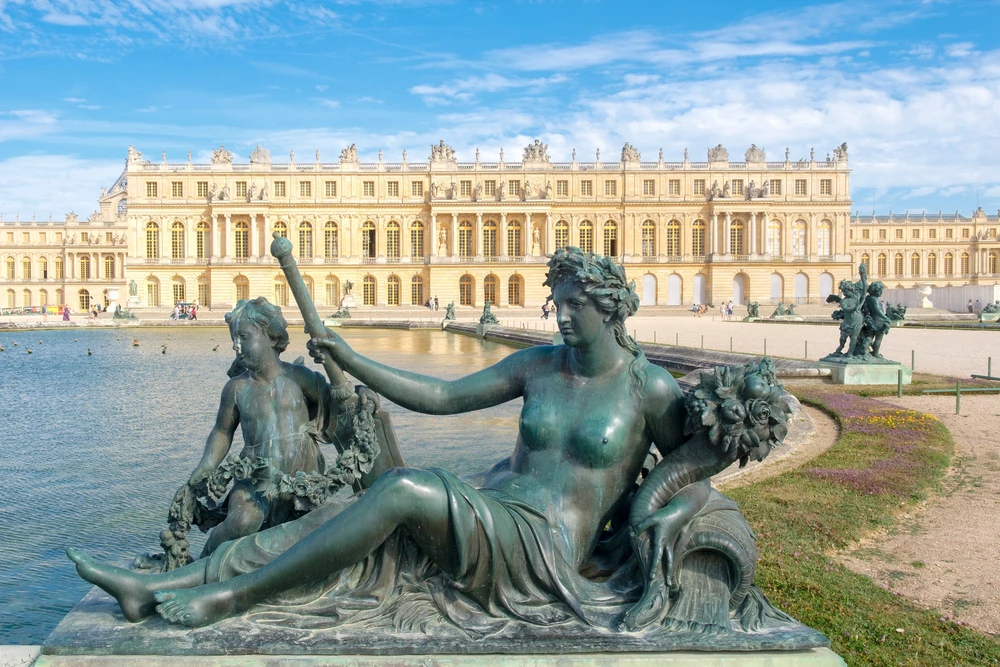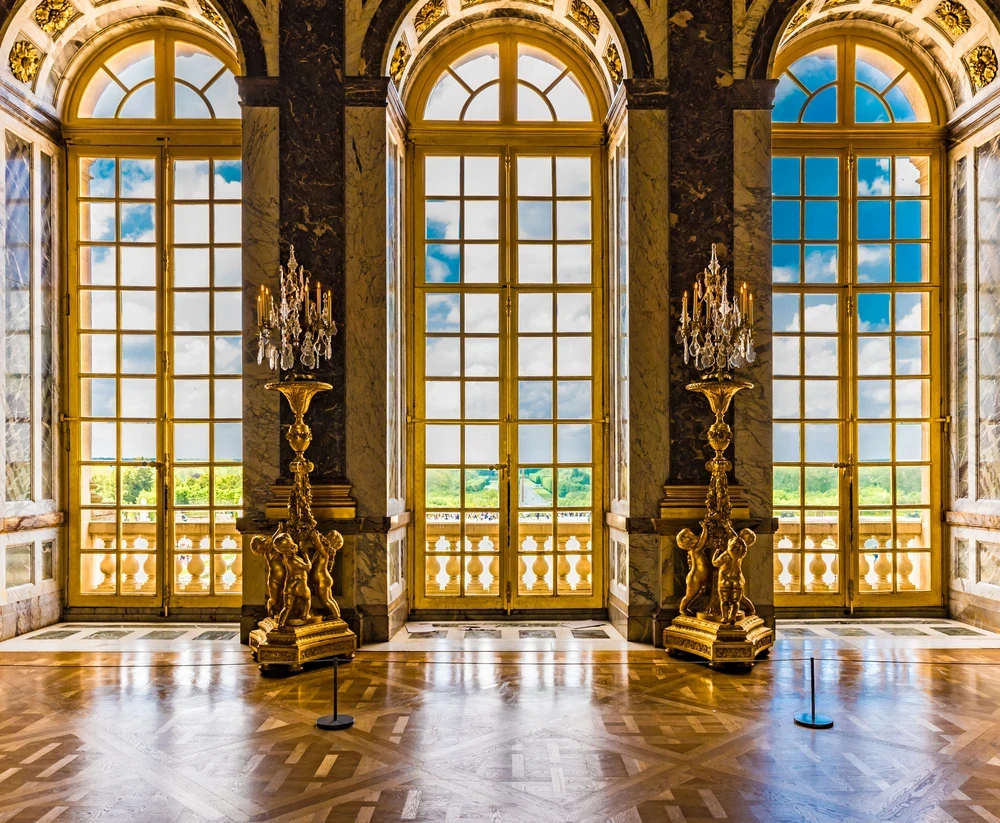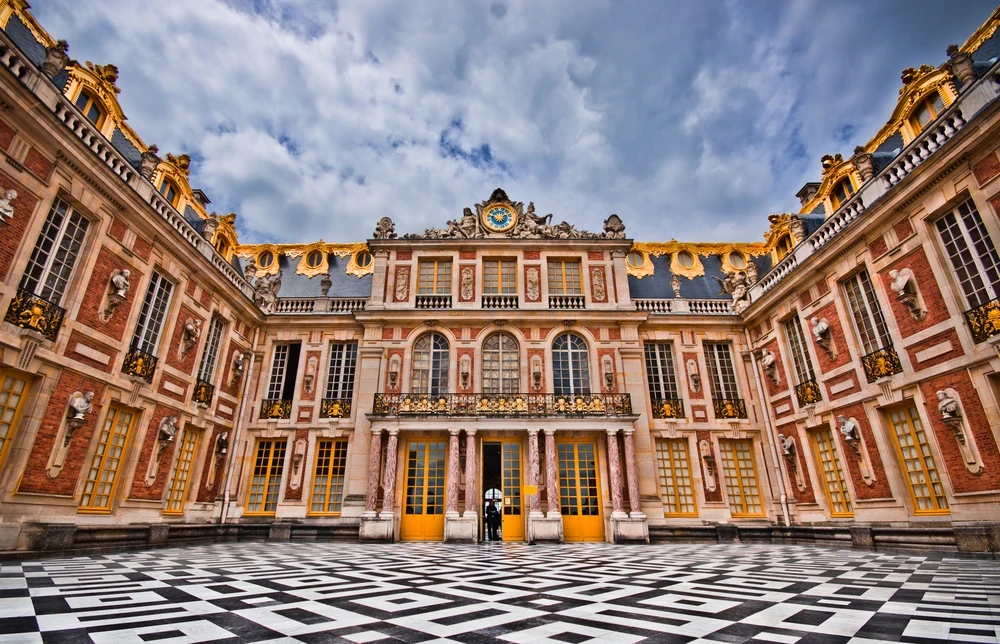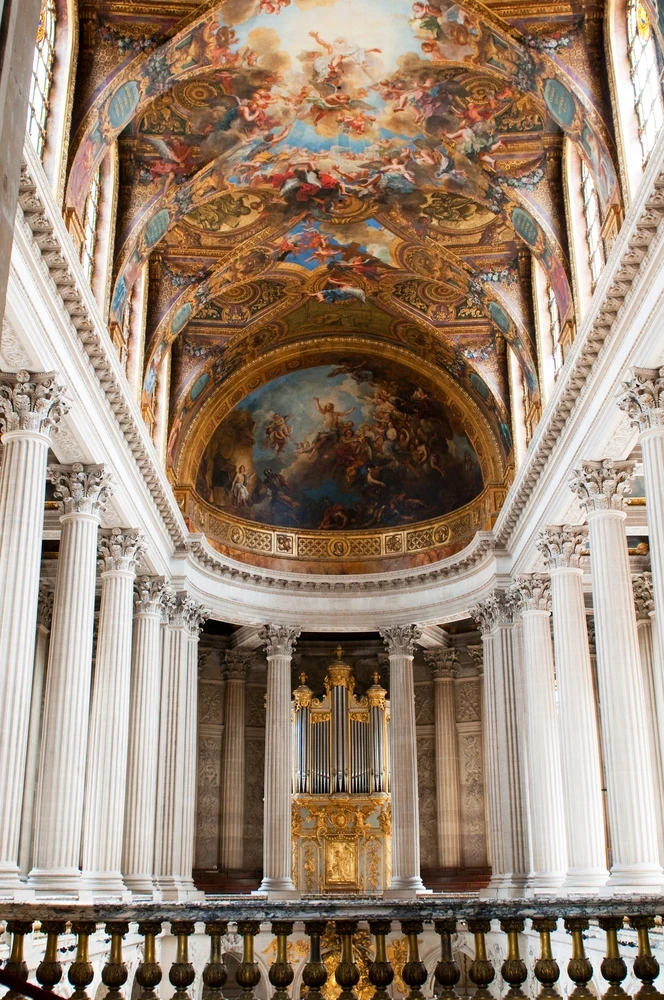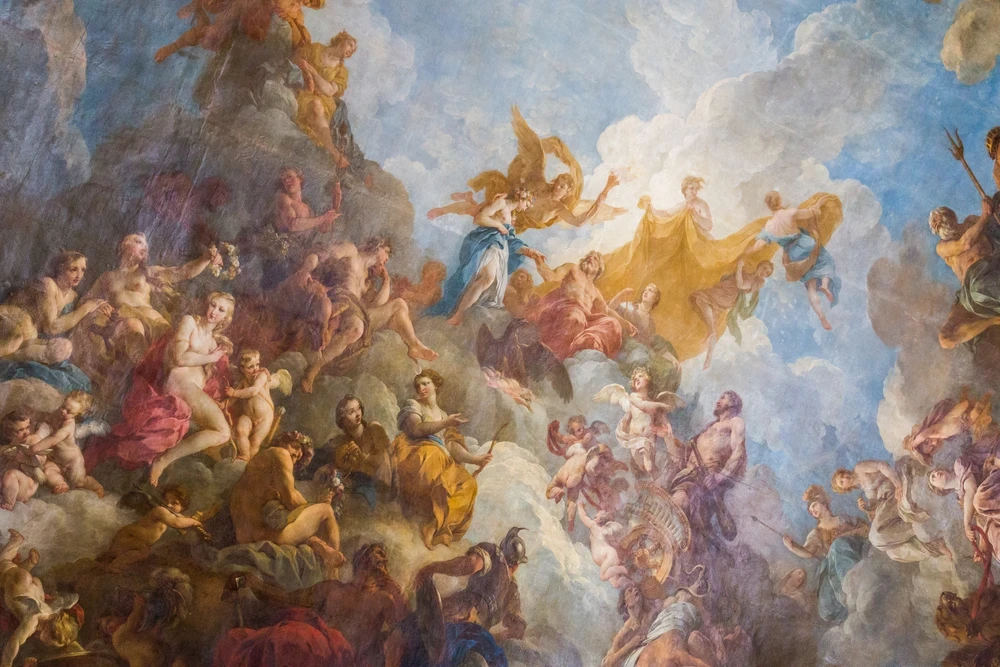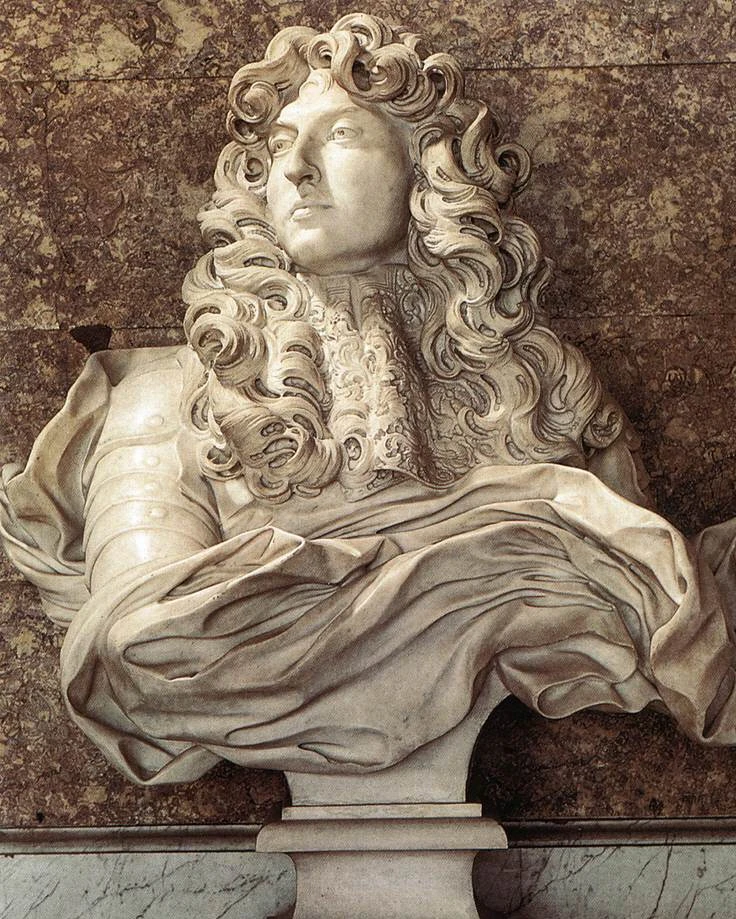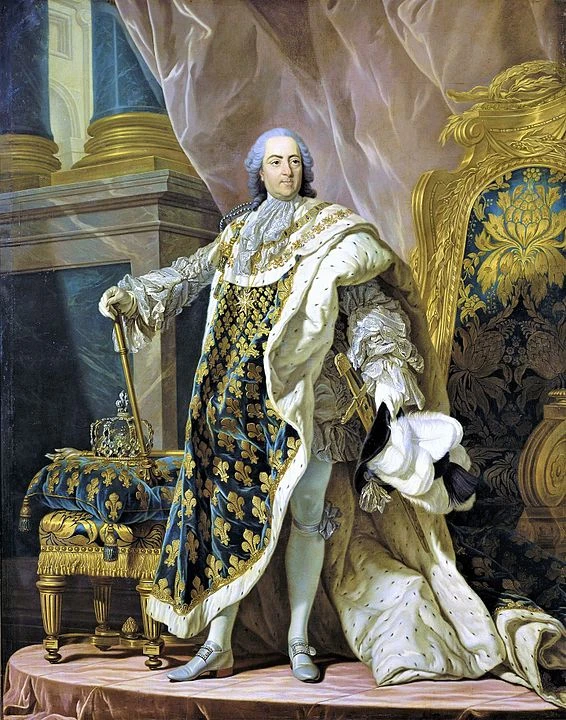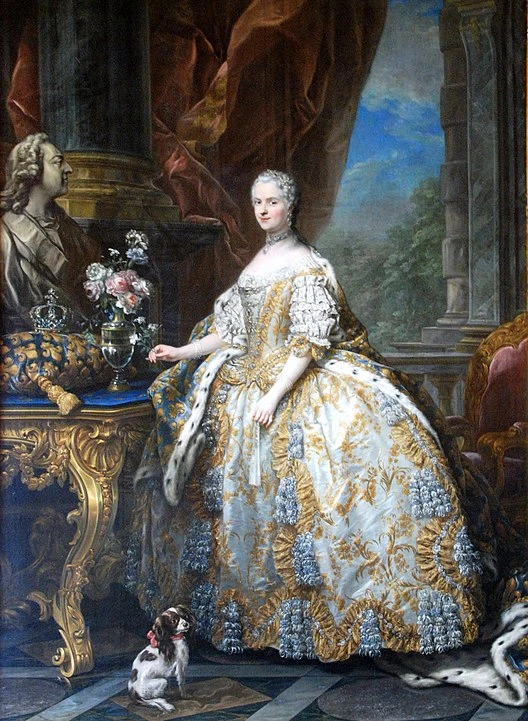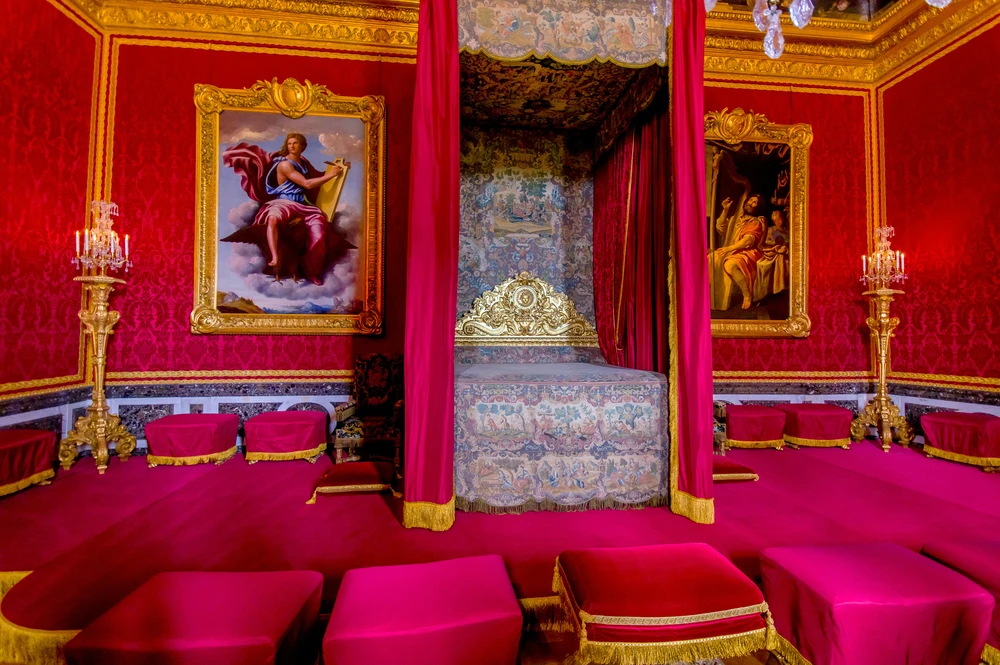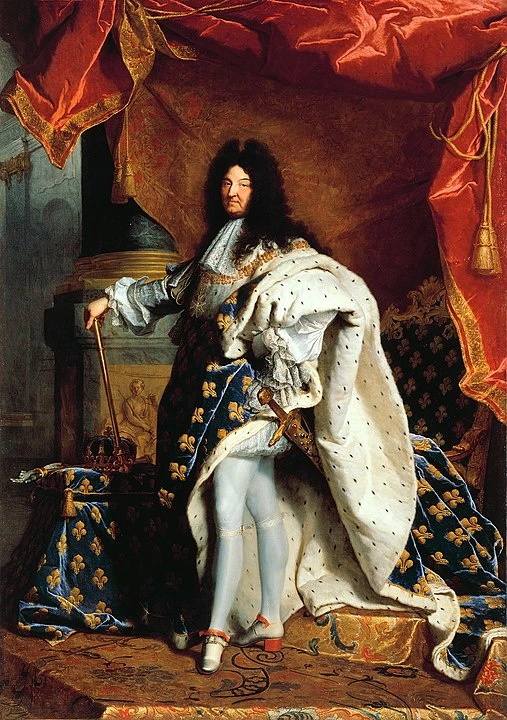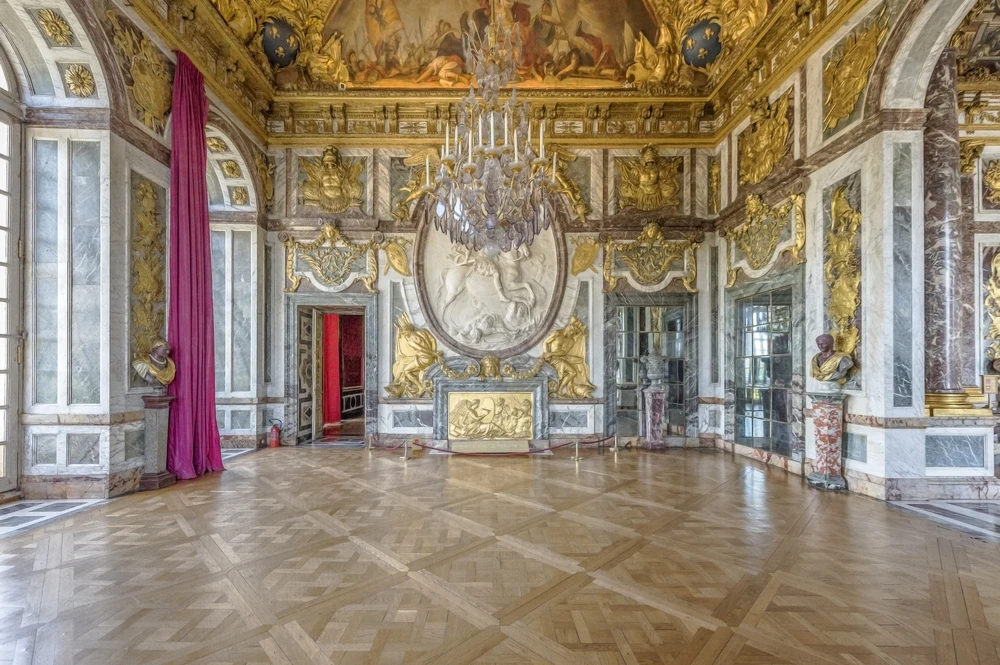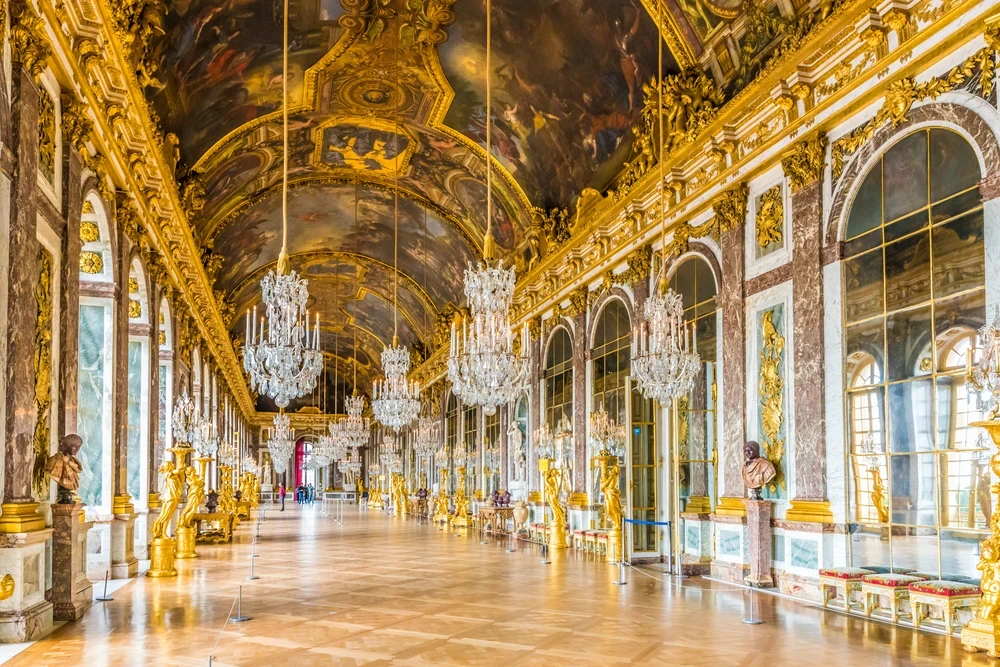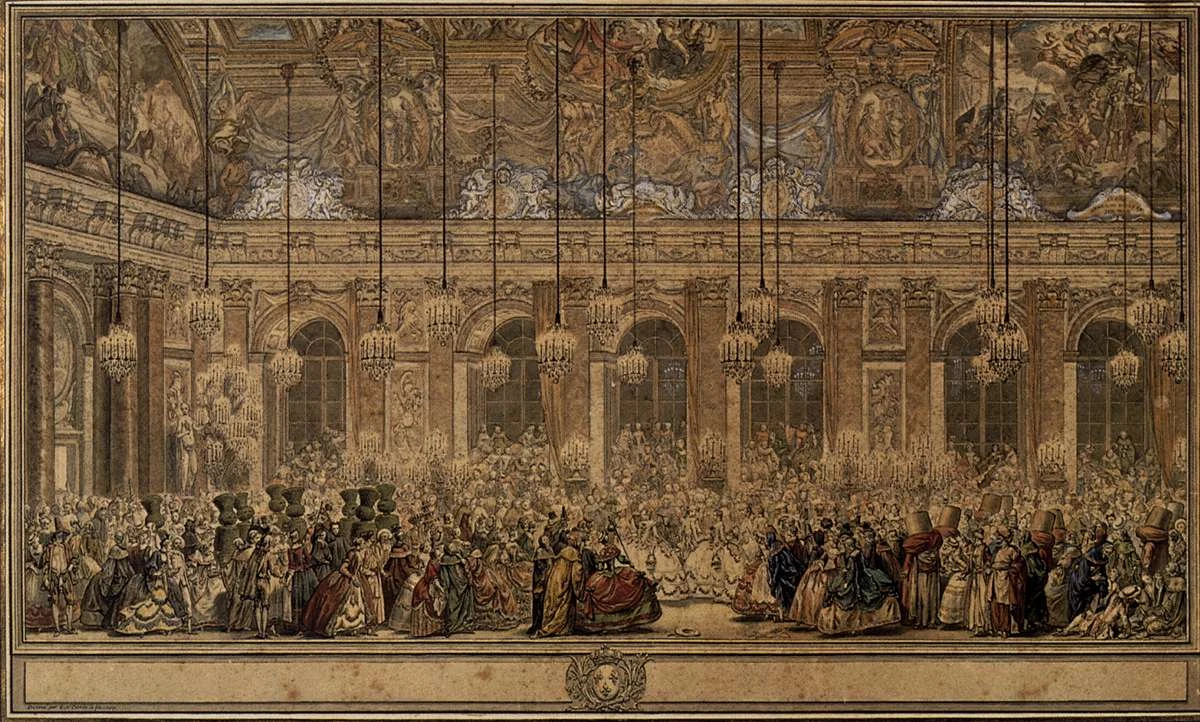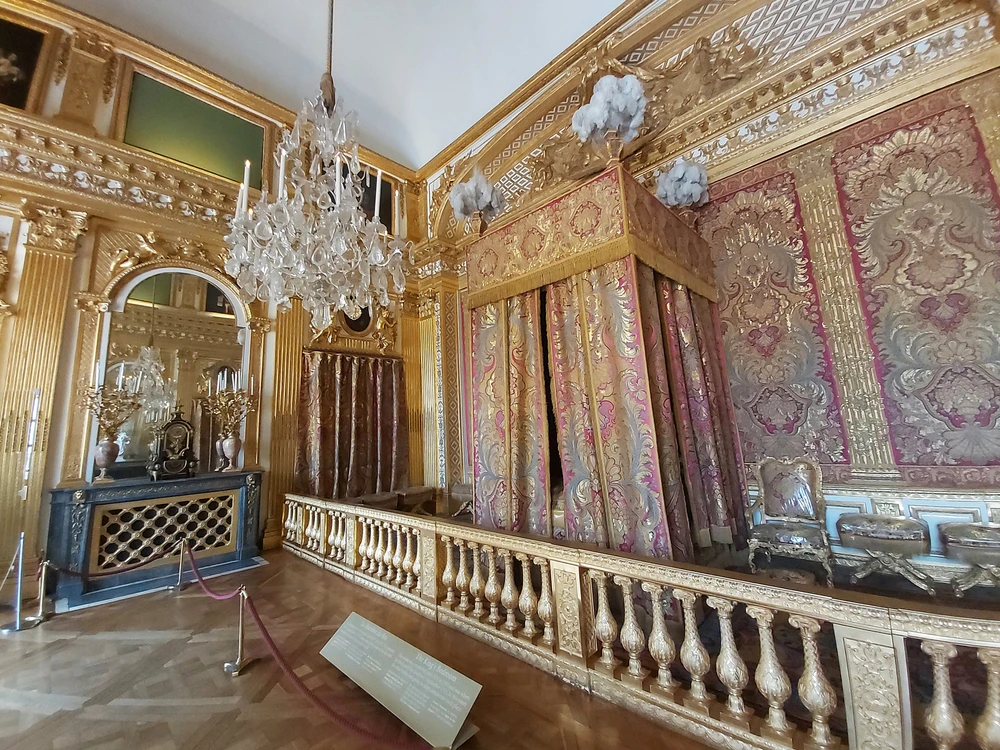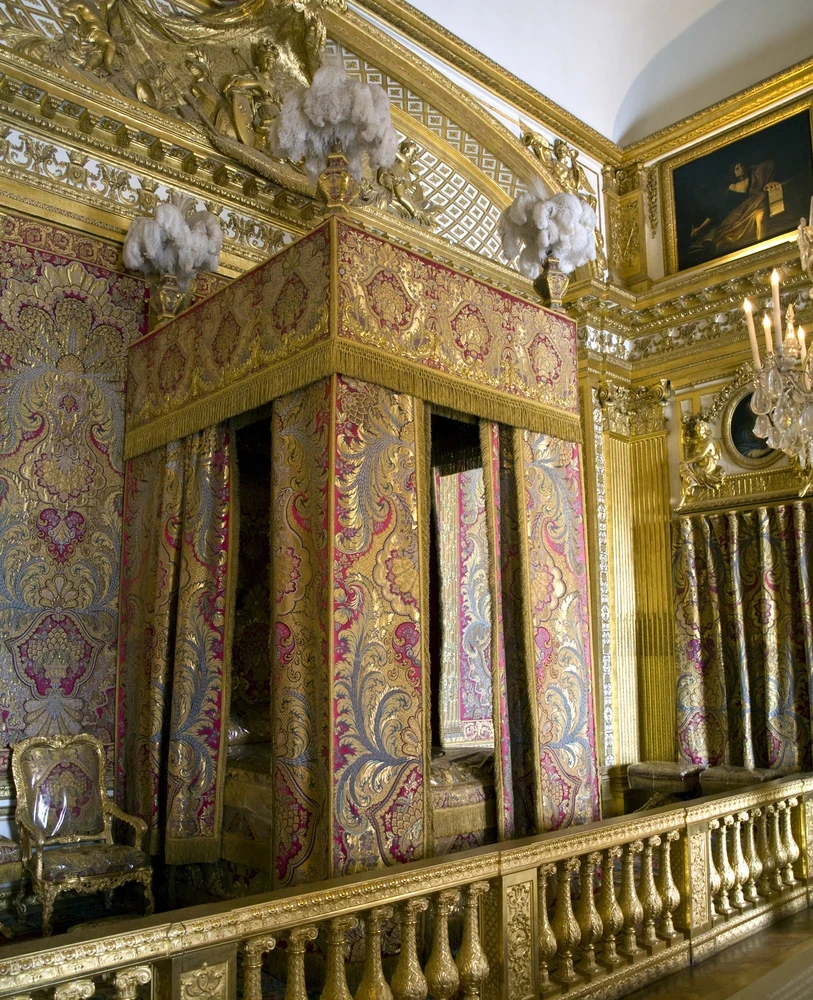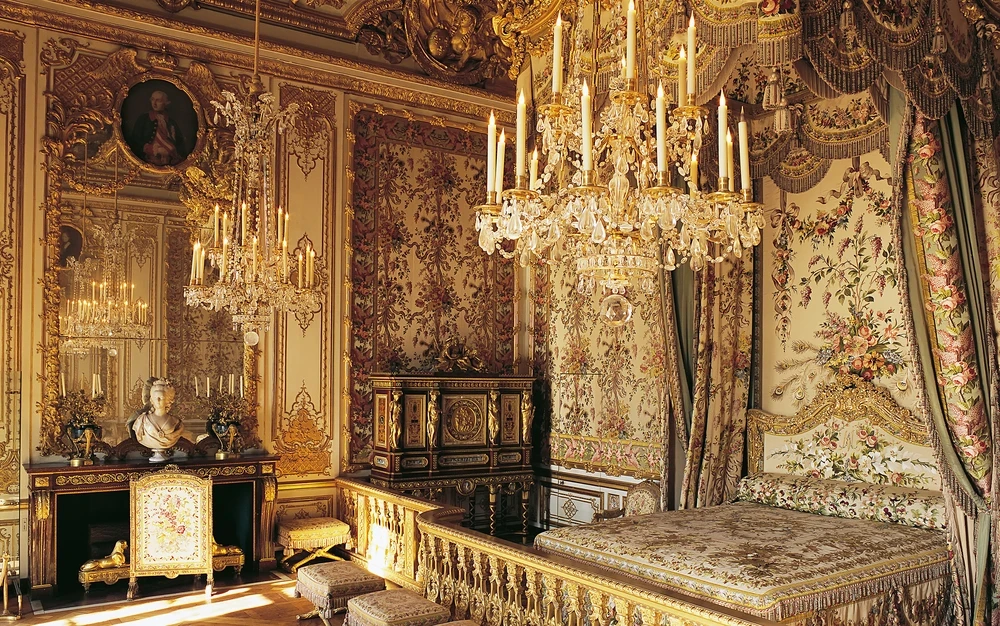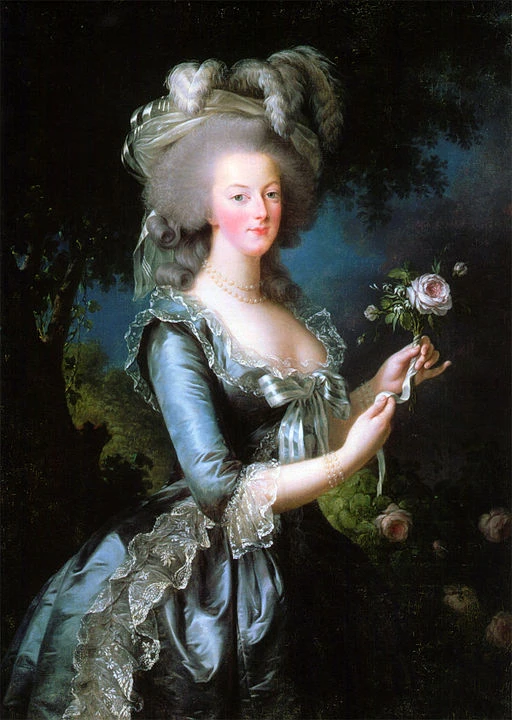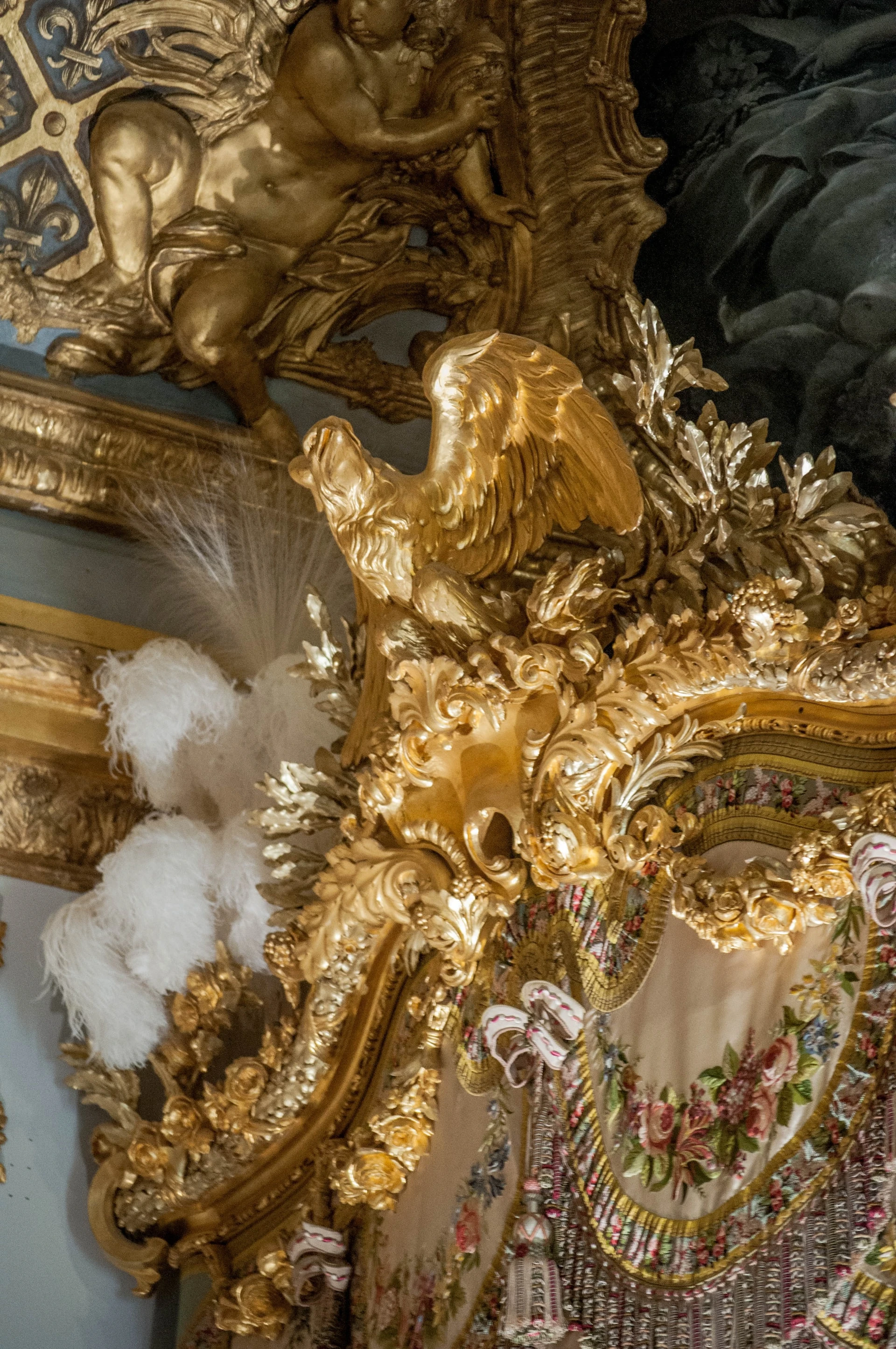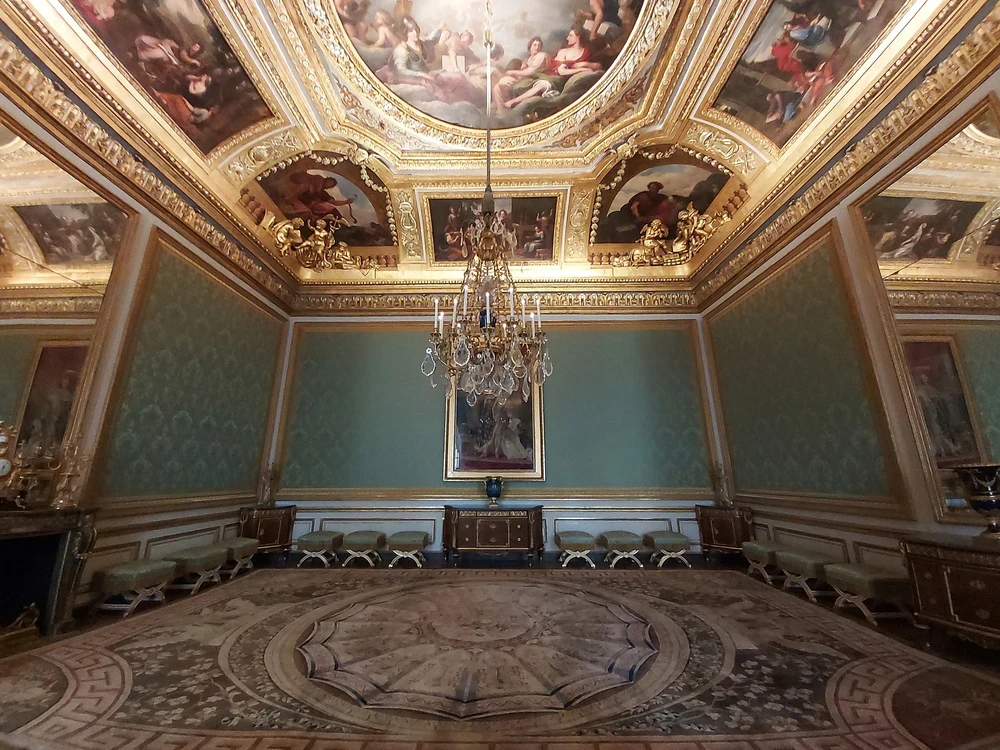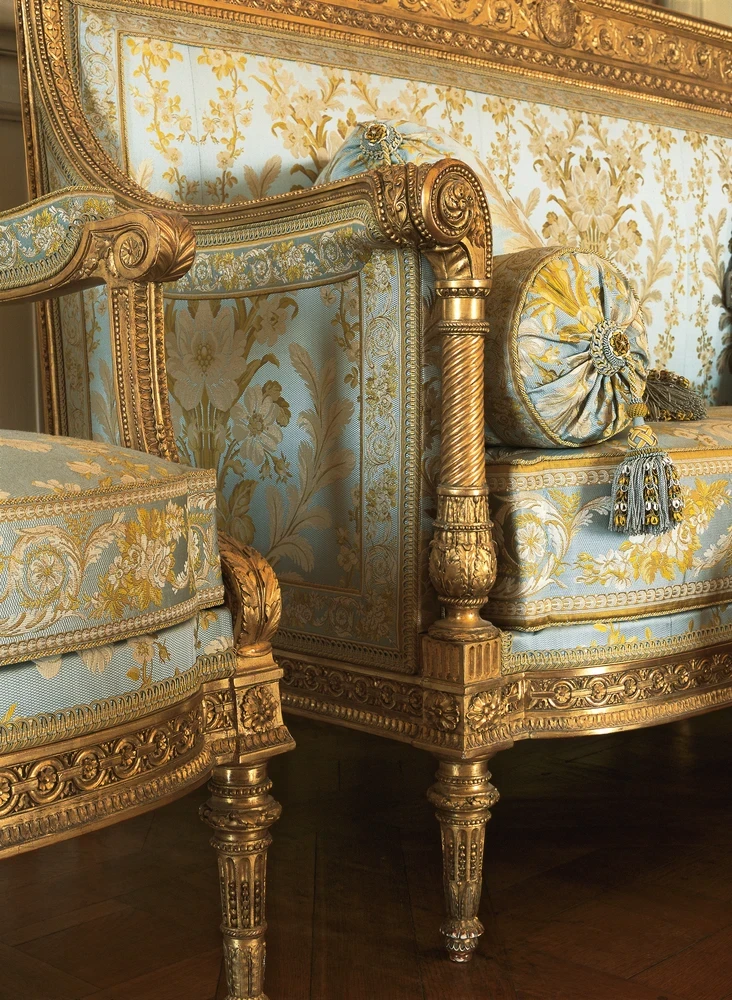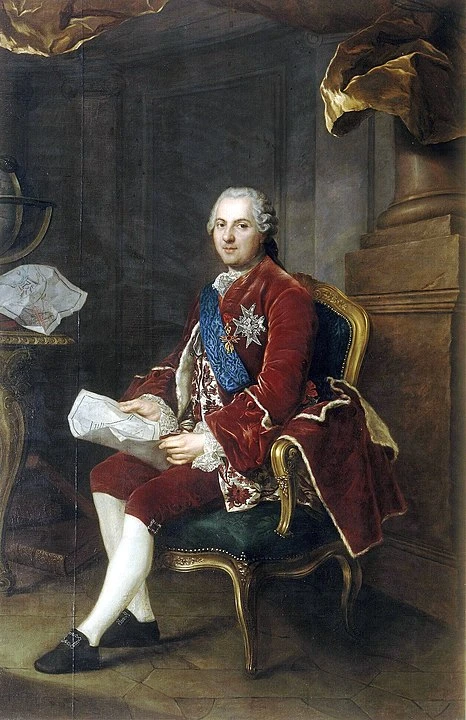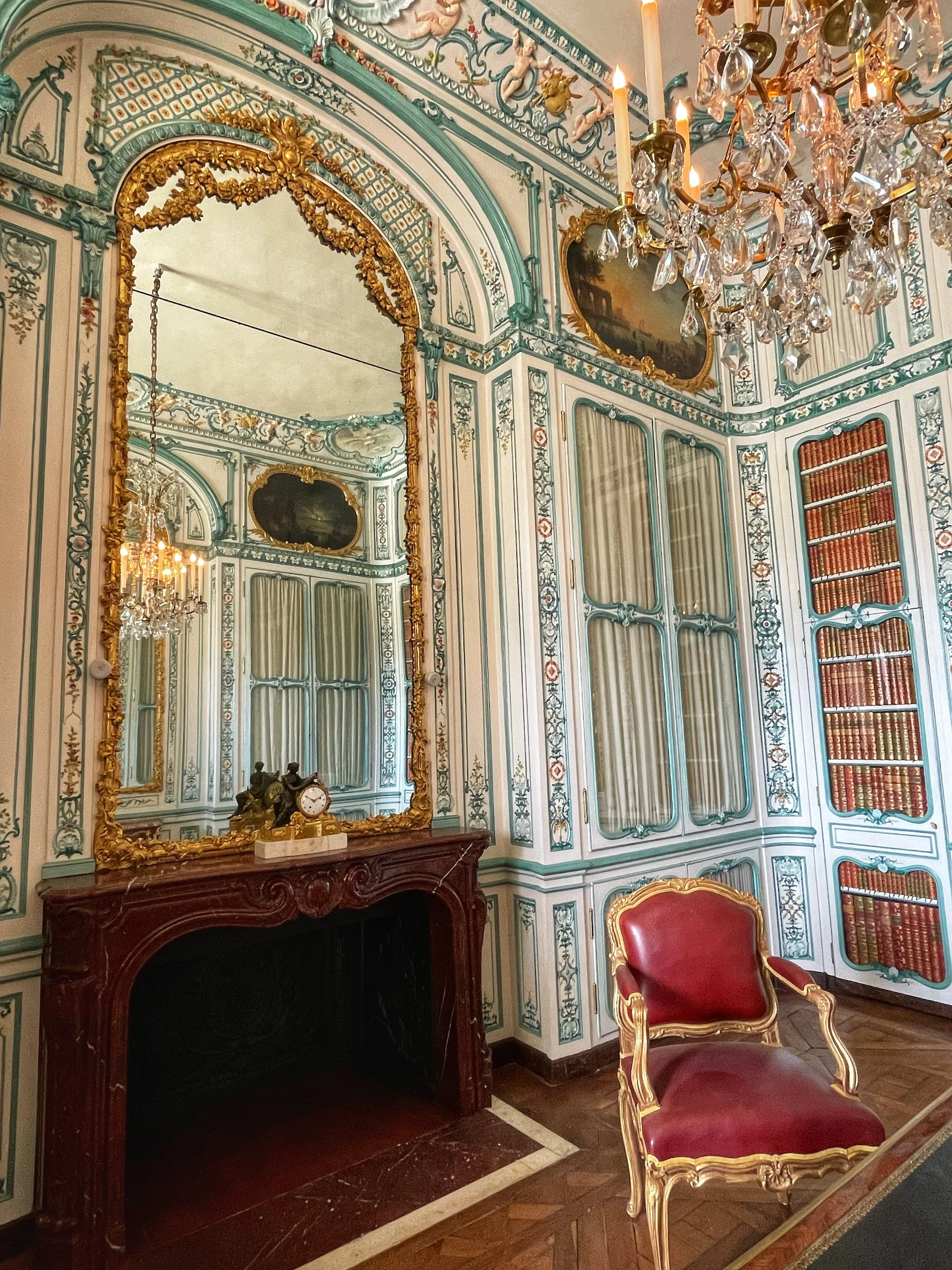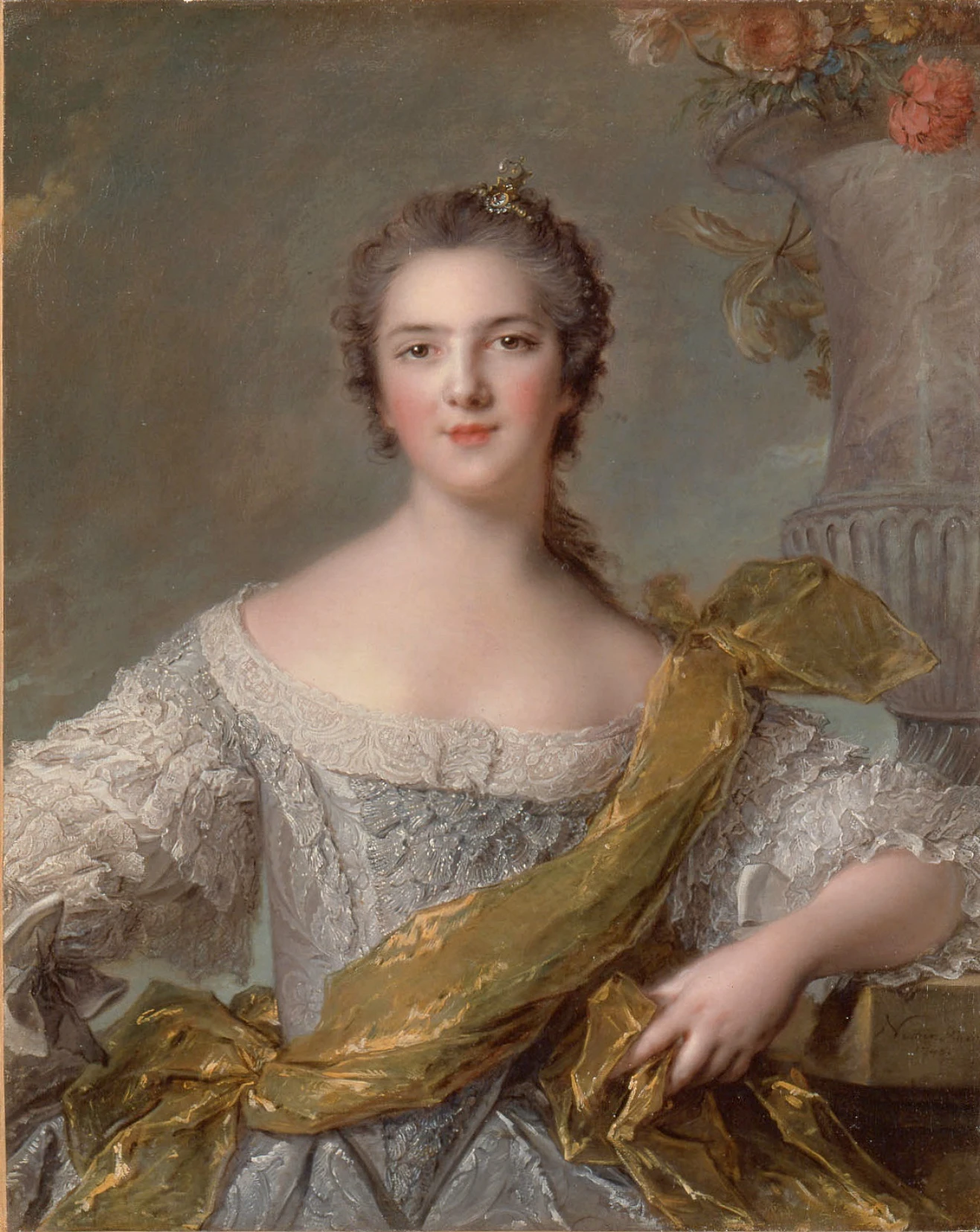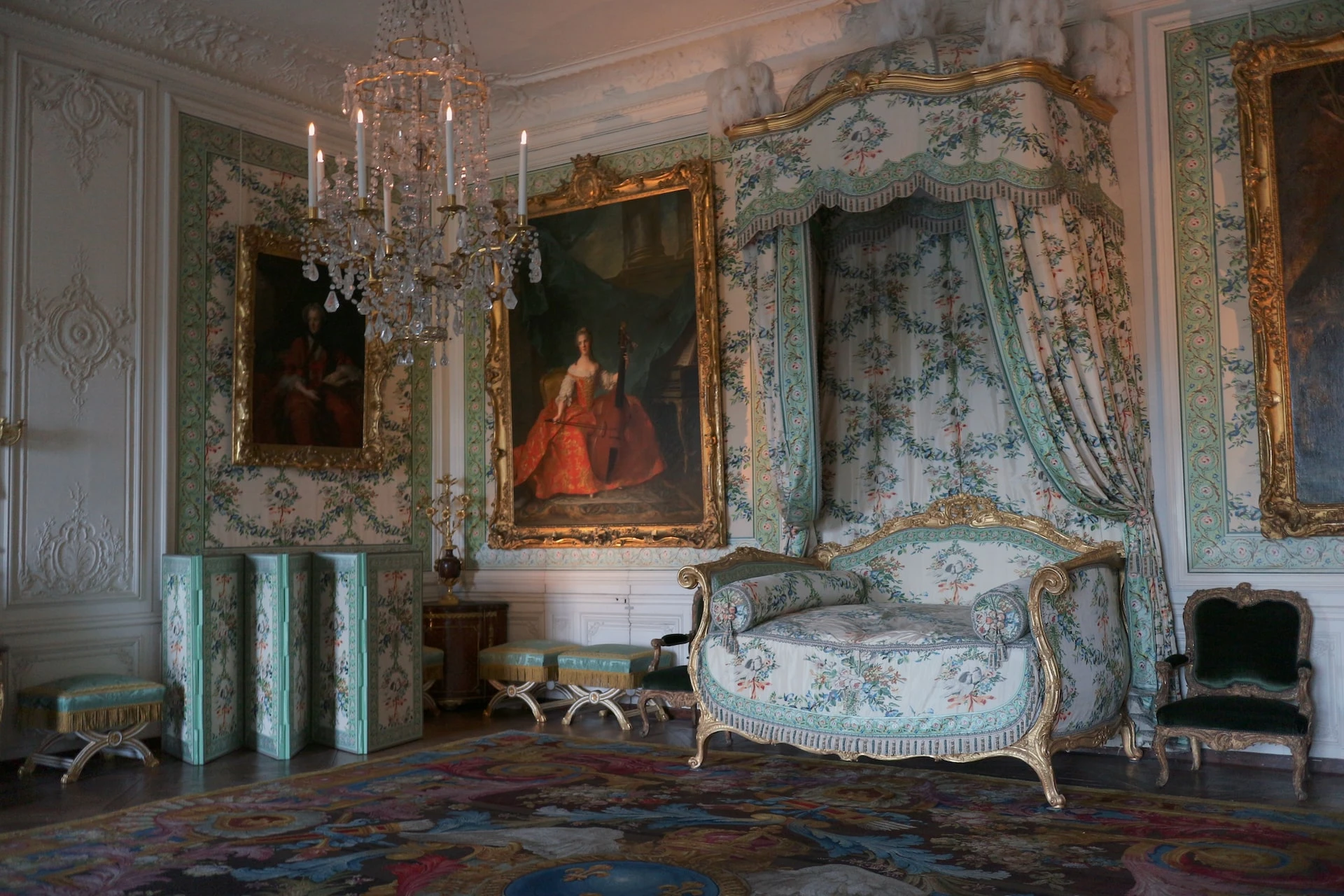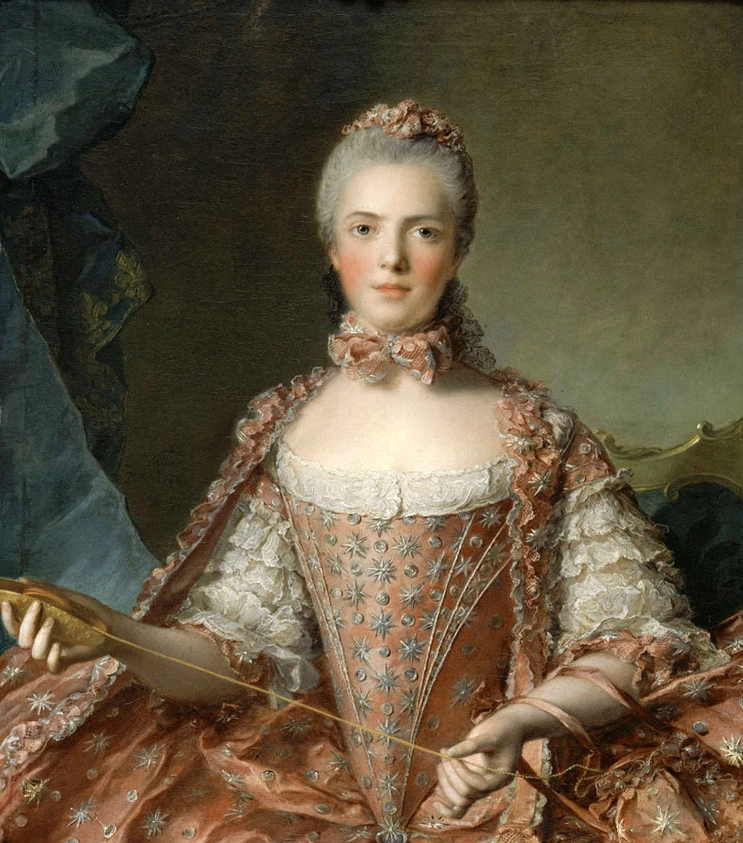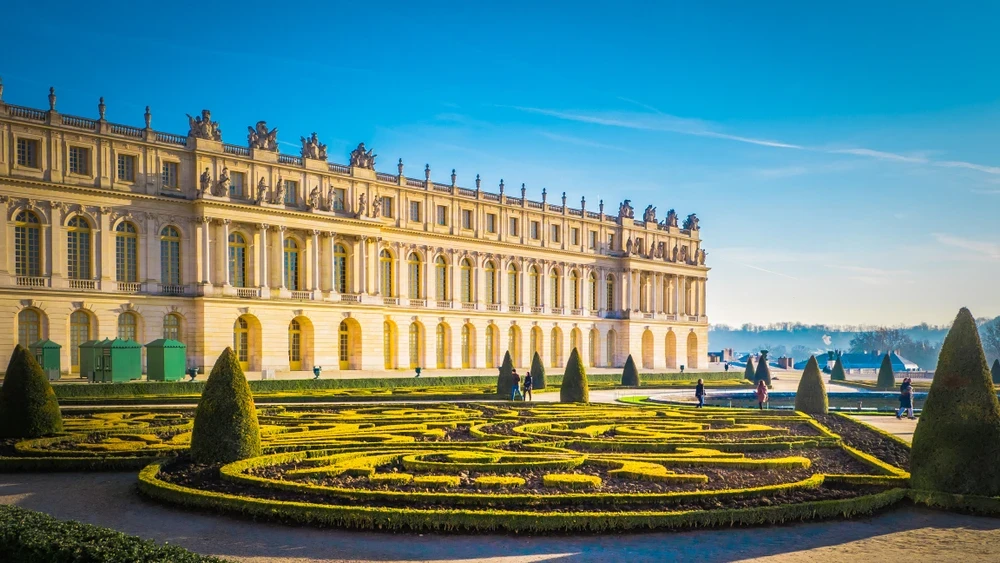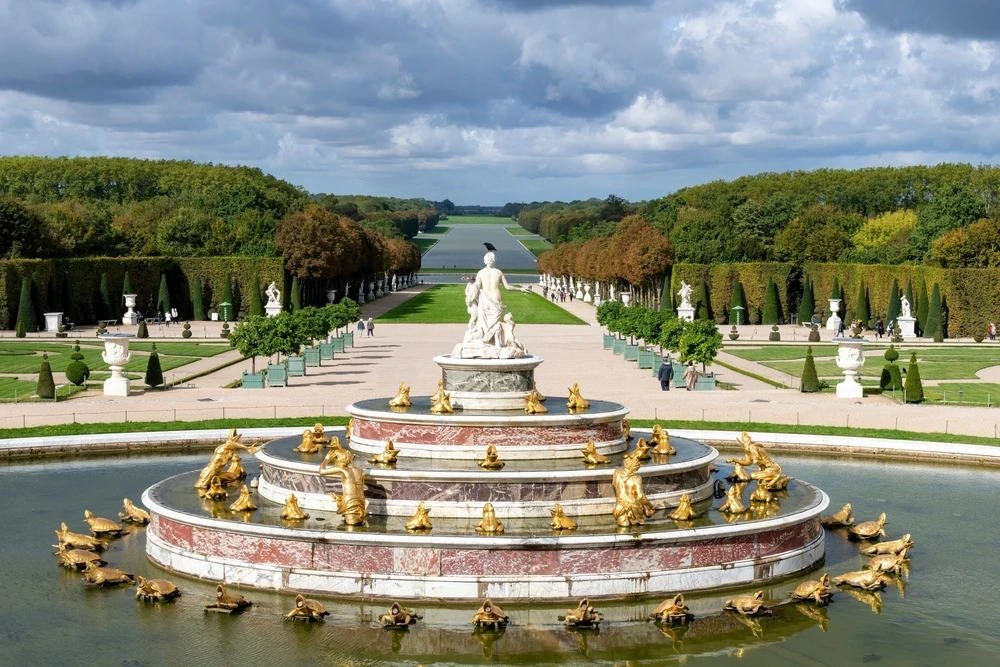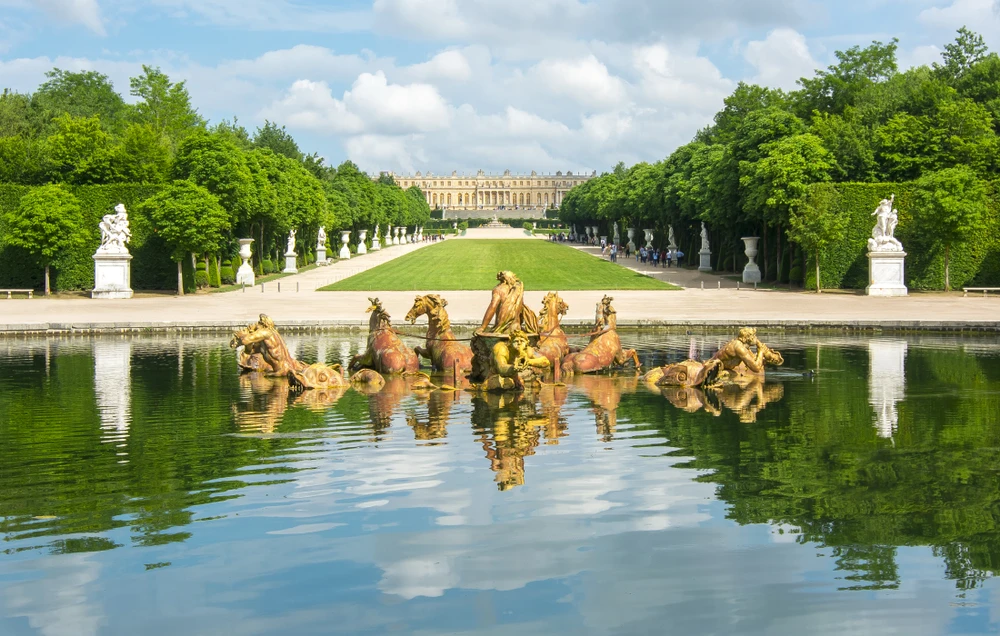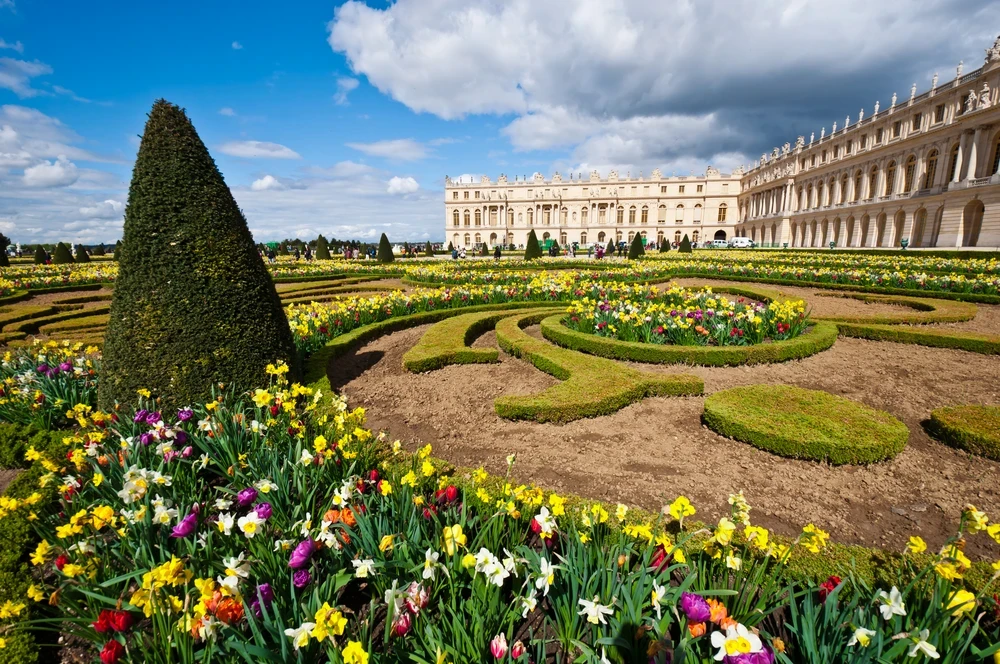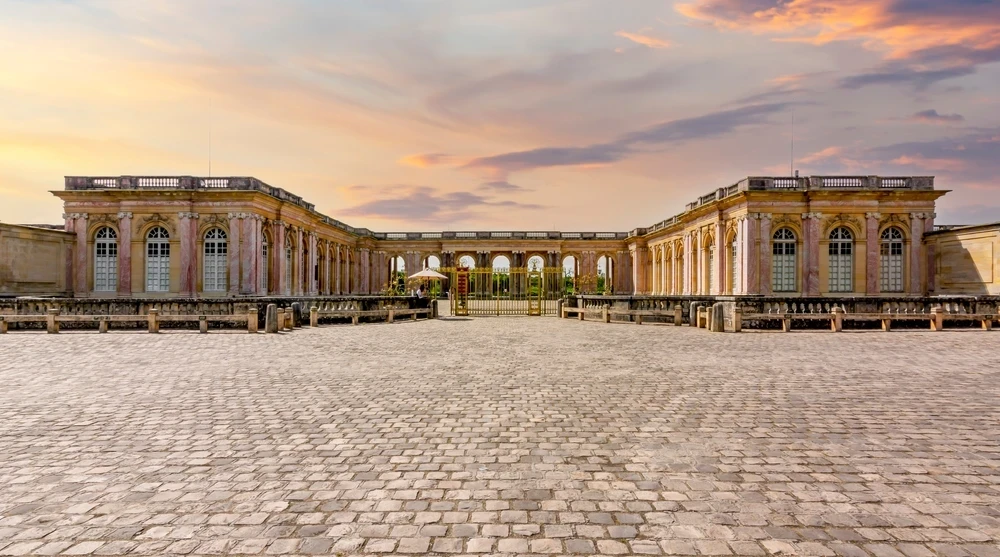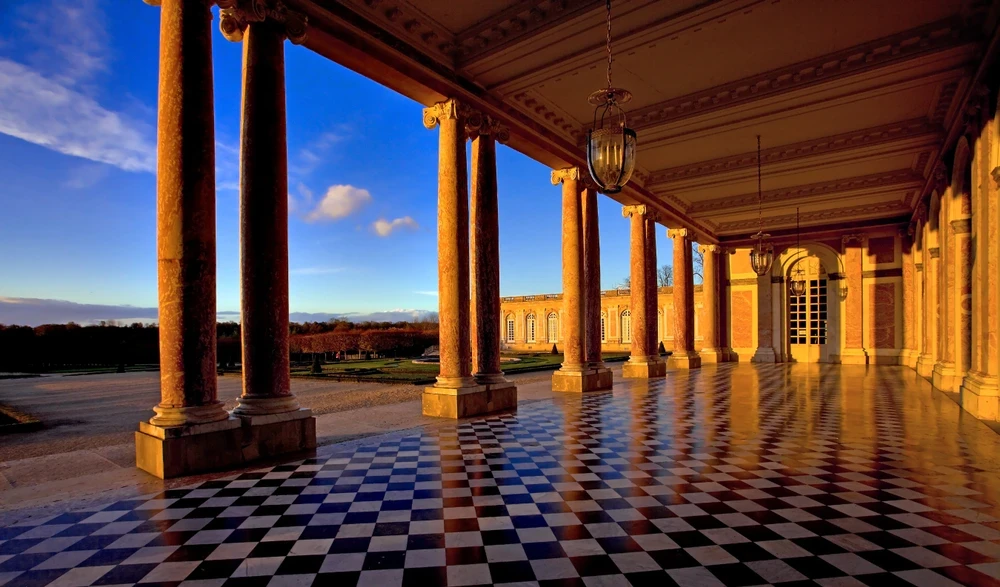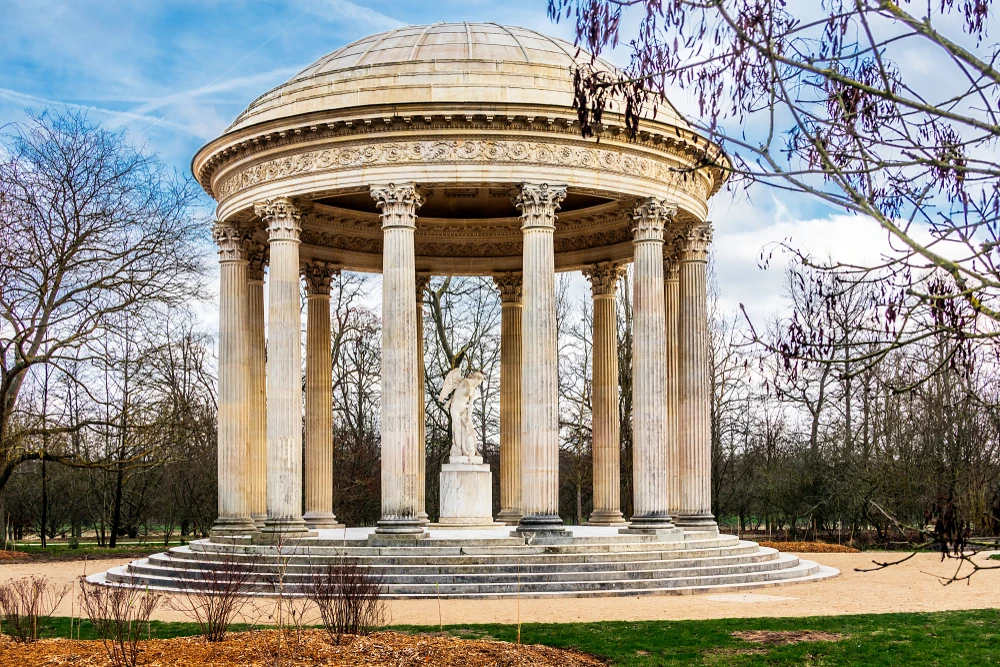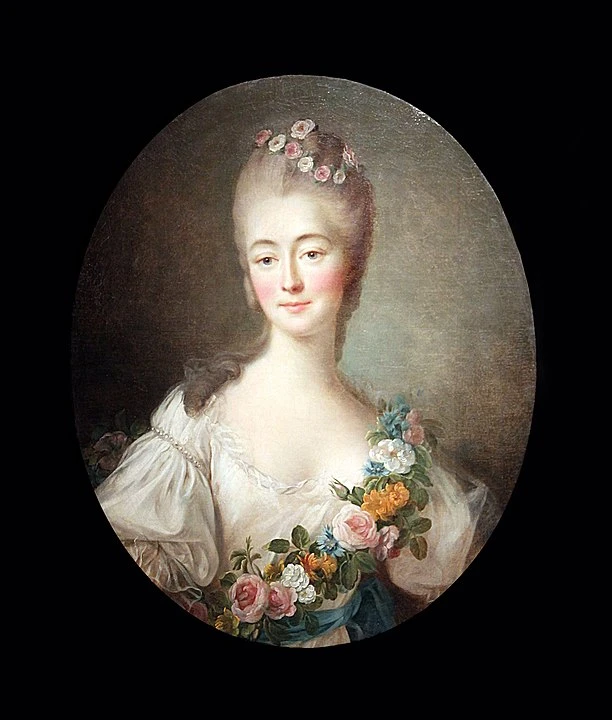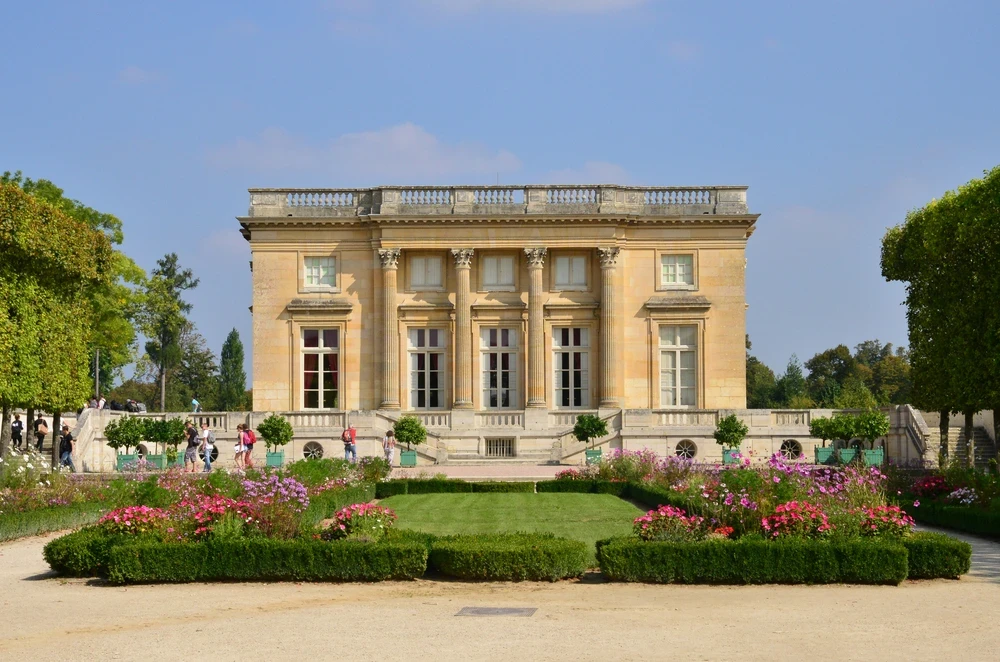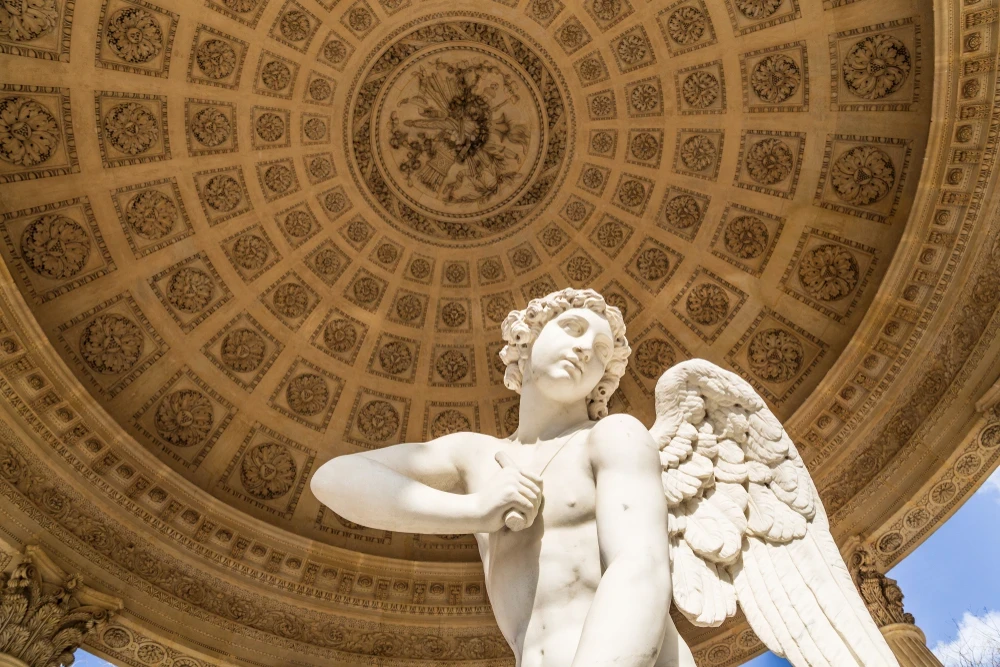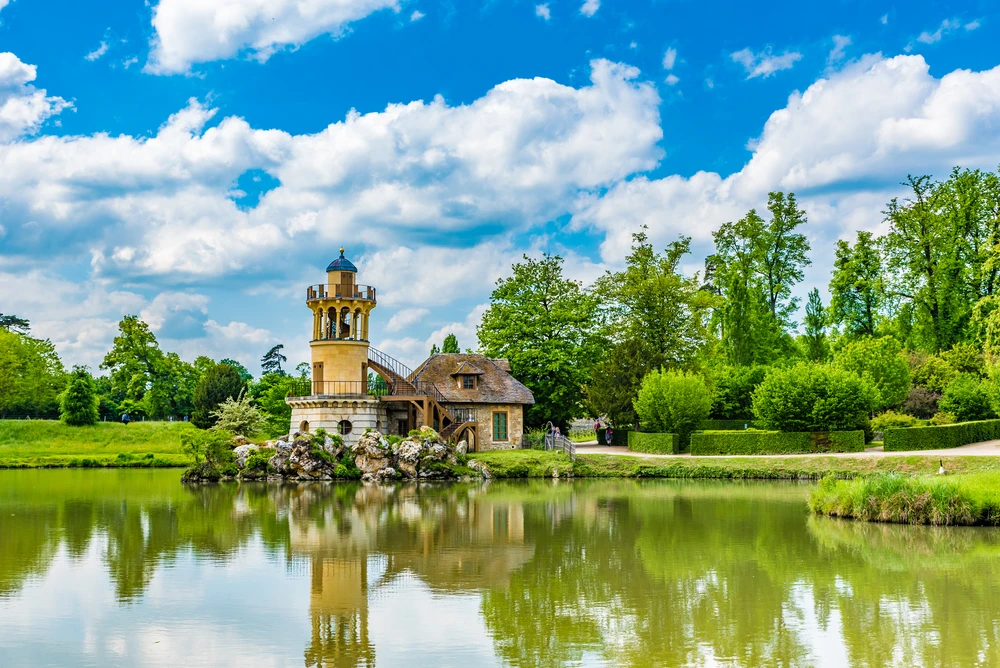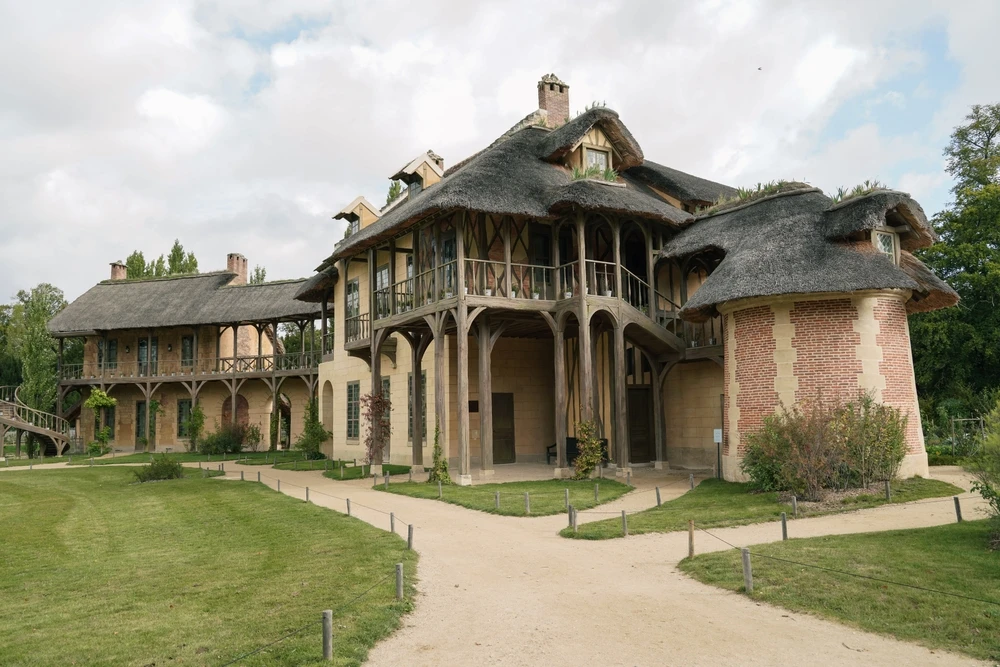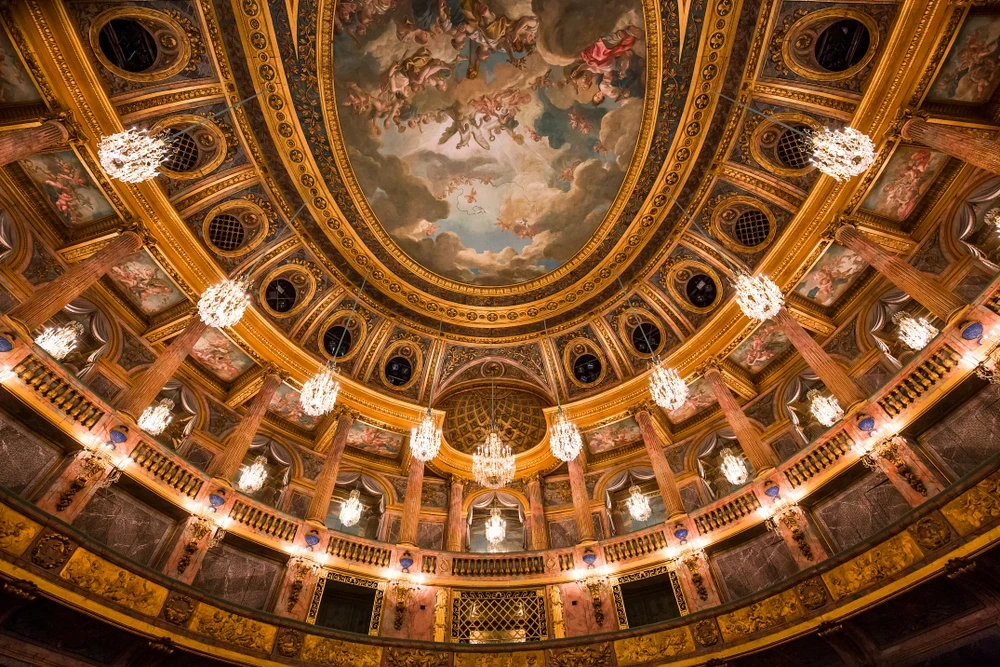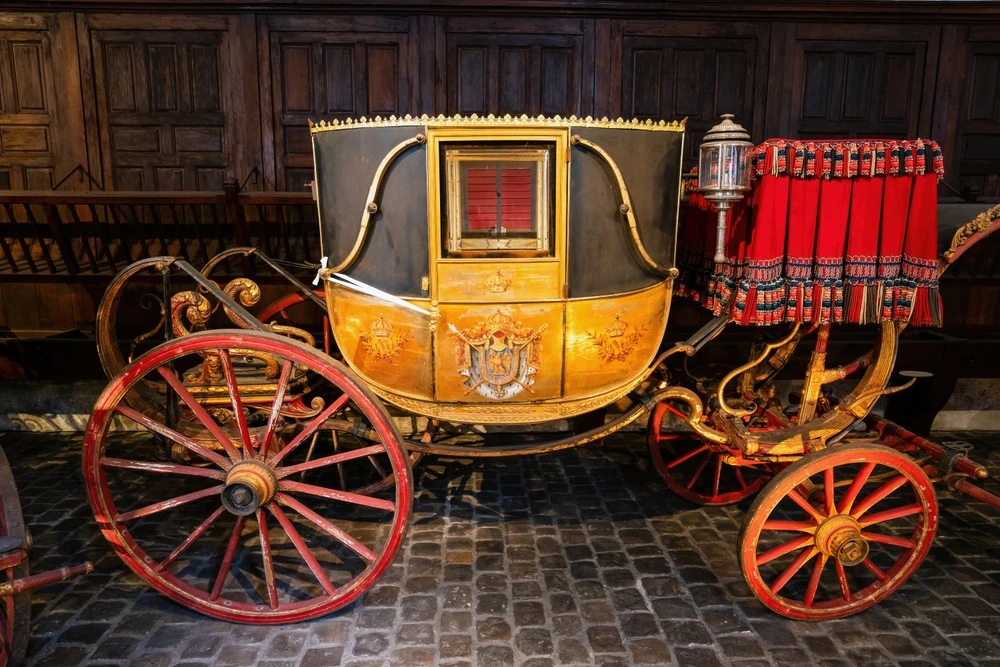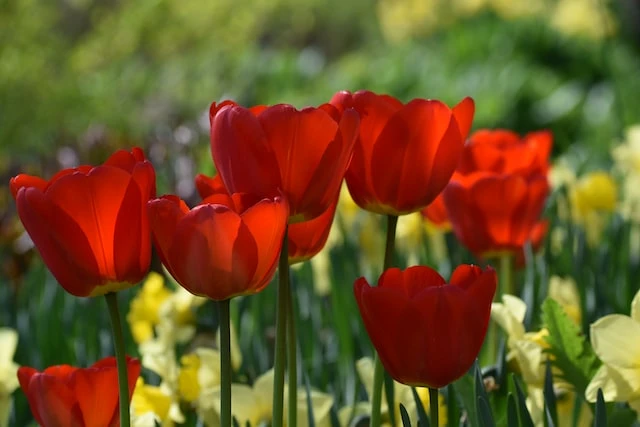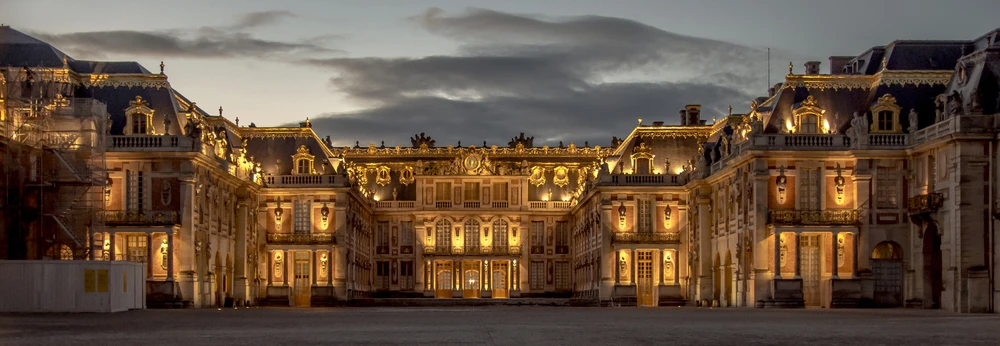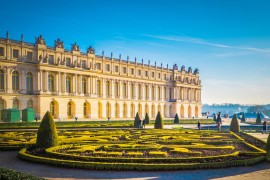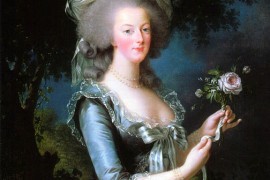Versailles: Where? When? How? How much? Practical info :
The main gate of the main courtyard. To the left is the entrance to the château by juan Esteban Villa/Shutterstock.com
GPS address Versailles :
Place d'Armes, Versailles. The Château de Versailles is located in the Yvelines department. It is 30 kms from Paris.
How to get to Versailles by car / parking lots
Put "Place d'Armes Versailles" on your GPS. It's not the best way to get there, but you'll find parking spaces in front of the château and around the Place d'Armes, but they fill up fast. Parking is also available along the three main avenues leading from the château: Avenue de Paris, Avenue de Saint Cloud and Avenue de Sceaux. In fact, 1 km up the Avenue de Paris, you'll find more affordable parking than in front of the château (where you'll pay 30 euros for a day).
By cab or Uber, there are stations. Depending on traffic, a trip to Paris can cost up to 100 euros.
Take public transport to Versailles.
It's easy to reach by public transport from Paris.
From central Paris: By train, choose the "Versailles Château Rive-Gauche" station. It's 10 minutes from the château entrance. The station can be reached in 45 minutes from Notre Dame on the RER C , an easy-to-find line that crosses Paris via the great classics like the "Saint Michel" and "Notre-Dame" metro stations.
From Montparnasse and La Défense: You can also come from Gare Montparnasse or La Défense, this time taking the Transilien SNCF line N and stopping at "Versailles Chantier". You'll need to walk a little, about 20 minutes, to reach the château.
TIP: buy both the outward ticket and the return ticket so you don't have to queue when you return, as many tourists buy the return ticket on the way back, which means a long wait in front of the ticket machine .
The Marble Courtyard. This is where you enter the château /Photo by andre quinou/Shutterstock.com
Château de Versailles opening hours:
The château is open daily all year round EXCEPT MONDAY.
It is also closed on December 25, January 1 and May 1.
There are two seasons : low and high.
In high season
(from April 1st to October 31st) the château is open from 9H00 to 18H30 (last admission at 18H00) and the park from 7H30 to 18H00. Trianon is open from 12:00 to 18:30.
Low season
(November 1 to March 31) the château is open from 9.00 am to 5.30 pm (last admission at 5.00 pm) and the park from 7.30 am to 8.30 pm . Trianon is open from 12:00 to 17:30.
Please note: the park sometimes closes early: on Saturdays with high water from June 16 to September 15, it closes at 5.30 pm. Similarly, weather conditions may require the park to be closed for the safety of walkers.
TIP: come on Wednesdays and Thursdays, or even Fridays. Avoid weekends if possible. And don't hesitate to visit Versailles in late autumn or early spring. The park is less crowded and just as beautiful.
The sun, the symbol of Louis XIV, is featured on a number of items, including honorary railings / Photo by trucic/Shutterstock.com
Versailles rates:
Tip: As a general rule, get your tickets online, so you don't have to queue at the entrance and can go straight to entrance A. The price may have changed since this article was written. Check on the Château website.
1 Admission to the château is 21 euros (2024)
It gives access to the famous Hall of Mirrors, but also to the King's apartments, the Grand Apartments, the chapel and the Queen's bedroom. Please note that it does not give access to the gardens or Trianon (Trianon entrance costs 12 euros), but it does allow you to visit the château if you don't have much time. You can find it here.
2 Full 1-day passport costs 32 euros (2024)
It gives access to the entire château, as well as to the park and the Trianon estate. This is the ticket to get if you're planning a day at Versailles. You'll find it here.
Please note that you may have to wait 1 or 1.30 hours before entering the château. In any case, get your tickets before you come, on the Internet, and plan to be there at 8:30 in the morning or around 1:00 if you want to wait as little as possible.
3 The best: The 1-YEAR-IN-VERSSAILLES passport
It costs 65 euros. It gives access to the "coupe-file", so you can go straight to entrance B and avoid waiting (too long). You have access to the entire Versailles estate, including the Trianon, which you absolutely must visit. You'll also receive a nice magazine, and access to a wide range of cultural offers. This is the formula we recommend if you can afford it. It offers optimum comfort (there's a duo offer for 90 euros), which you can find here. It's valid for 1 year, so who knows if you won't be back within the year?
There are free admission or group admission options, as well as guided tours (from 40 euros), which enable you to discover a particular facet of Versailles, and which are described in detail on the Château de Versailles website.
Inside the château / Photo by Matthew Jacques/Shutterstock.com
Versailles: Luggage, toilets, what to do?
Toilets:
In the château: It's been said that there weren't many toilets at Versailles during the reign of the Sun King, and if that's true, it hasn't changed much. However, you'll find them at the château entrance, after the checkpoints. You'll also find some further down on the first floor, but please note that there are none on the 1st floor (the grand apartments, the Hall of Mirrors, etc.). You'll find more on the way down at the end of the tour.
In the park: There are some near the bosquet de la girandole, in the axis of the château, and at the other end of the Grand Canal. There are also some at the entrance to the grand and petit Trianon.
luggage and final tips :
Please note that bulky luggage is not permitted in the château. The same applies to strollers. You can leave them at the lockers. Photos are permitted, but without flash , and selfie poles are forbidden (even if they're the only thing you see in the Hall of Mirrors...).
ALWAYS make a reservation and ask for information before you come.
As a general rule, always visit the Château de Versailles website a few days before you plan to visit. You'll know the opening hours and what shows are likely to take place. Take a close look at the sites displayed by your search engine: you won't necessarily come across the Château de Versailles site first, but you may come across tour operators.
Please note that the prices we give are for information only and are those we recorded on November 17, 2022. They are not guaranteed and do not engage the responsibility of the site. Always check the château's website before visiting.
The gilded entrance to Versailles / Photo by FrimuFilms/Shutterstock.com
Versailles : What to see? What to see?
Detail of the Hall of Mirrors at the Château de Versailles Takashi Images/Shutterstock.com
Visit the Palace of Versailles
First of all, don't forget to take the audioguide. You'll always learn more. The official app is also very good, and we recommend it. There are several itineraries. If you're in a hurry, we recommend the large apartments route.
If you have more time, you'll be able to discover other tours here, including the grand apartments of the Dauphin and those of "Mesdames", Louis XV's daughters.
The "Grand appartement" course
To discover it, cross the Cour de Marbre. Take the opportunity to look at the facades, their busts, and their style, which tells the story of this château so well: a hunting lodge of Louis XIII (Louis XIII architectural style can be seen in the bricks and white stonework), which his son, Louis XIV, literally enveloped in another, much larger construction. There was a project to bring this part of the building up to 17th-century standards, but it was halted by lack of funds and the French Revolution. You can see the beginnings of the courtyard on the right, the courtyard that precedes the marble courtyard, with a small colonnade. Once you've crossed the courtyard, you'll go up to the second floor and discover :
The Marble Courtyard with the facades of the first château, that of Louis XIII / Photo by Fotos593/Shutterstock.com
1 The upper lounge :
Completed in 1710, it overlooks the royal chapel from above. It was once one of the castle's chapels.
Versailles: the interior of the chapel as seen from the upper salon / Image by lexan/Shutterstock.com
2 Le salon d'Hercule :
This is the largest painted ceiling in the châtau: 142 figures painted by François Lemoyne in just three years, from 1733 to 1736, after nearly 20 years' interruption of work begun by Louis XIV but suspended on the King's death in 1715 before being resumed 18 years later.
The ceiling of the Salon d'Hercule at Versailles by François Lemoyne (painted between 1733 and 1736) Gilmanshin/Shutterstock.com
3 Le salon de Vénus
Venus is the Roman goddess of love. She is the entrance to the king's Grand Appartement. It was here that snacks were served during the Court's grand soirées.
4 Le salon de Diane
The salon is dedicated to Diana, goddess of the hunt. This is where the king used to play billiards. It's hard to imagine a crowd around him, and even bleachers to welcome his admirers. The king is still here, in a bust by Le Bernin.
Le Bernin's bust of Louis XIV / personal work by Louis le Grand Wikicommons
5 Le salon de Mars
Dedicated to Mars, god of war, this was the first official room in the king's apartment. It was here that the French Guards were stationed to watch over the King. You'll see a portrait of Louis XIV above the fireplace, by René-Antoine Houasse. There are also two portraits by Carle Van Loo (originally from Nice), one of Louis XV and the other of his wife, Queen Marie.
Louis Michel van Loo, Louis XV, roi de France et de Navarre, 1760 (Château de Versailles)
Queen Marie Lezczinska by Carl Van Loo (Château de Versailles)
6 Mercury's living room
Mercure lounge, interior view Fotos593/Shutterstock.com
Also known as the "bedchamber" because this room was long the king's parade room, even though he slept in it very little. This salon was completely refurnished in 2012. It features a number of "ployants". These seats illustrate Etiquette (protocol), since only the most titled could sit on them. Of course, you don't sit in the presence of the king.
7 Apollo's salon
This is the throne room (its location is marked by a dais). For a long time, the throne was made of solid silver, before war forced the king to have it melted down to finance his armies in 1689 (and all the silver furniture at Versailles was melted down). Here, the king gives an audience. The room was also transformed into a ballroom for the "soirées d'appartements", the receptions Louis XIV often gave for his courtiers. The corners show the 4 continents (not 5, since Oceania was not discovered until well after Versailles was built). This salon also features the portrait of Louis XIV (by Hyacinthe Rigaud) in coronation regalia.
Portrait of Louis XIV in coronation costume (Musée du Louvre, oil on canvas, Hyacinthe Rigaud, 1701).
If you look at the painting, you'll see all the attributes of the French monarchy: the golden fleur-de-lys on an azure background, which adorn the ermine coat (ermine represents sovereignty), the sword, the scepter and the crown. Opposite the king is his great-great-great-great-grandson: Louis XVI.
8 The war room
It opens the Hall of Mirrors and leads to its counterpart (and opposite), the Salon de la Paix. It shows Louis XIV victorious on his horse.
The Salon de la Guerre at the Château de Versailles image for Frederic Legrand - COMEO/Shutterstock.com
9 The Hall of Mirrors
This is the most famous room in Versailles. 73 meters long, 13 wide and 12.50 m high. It was added later than many of the other rooms, as it was originally a terrace with a small fountain. The climate prompted this space to be closed off, and the opportunity was taken to turn it into a large gallery for receptions. It celebrates the greatness of Louis XIV. Not least with the more than 1,000 m2 of frescoes on the ceilings. Signed by Charles Le Brun (1619 - 1690), he was already 60 years old when the work began, which didn't stop him from painting them (and it's very inconvenient to paint a ceiling).
The Hall of Mirrors and its famous flares
It's adorned with marble and, above all, 357 mirrors - quite a feat at the time of its construction in 1679 , when France was just beginning to learn how to make them. It has to be said that Colbert succeeded in bringing in Venetian craftsmen to make the mirrors, at great expense, at a time when Venice was the only country to know how to make large mirrors. It was forbidden to share the secret on pain of death. It's clear that France had to pay a high price for this textbook case of industrial espionage, bringing in these workers who were first installed in Paris, before being sent to Cherbourg because the capital made them too turbulent (already Parisian nights!).
Great historic events have taken place here , such as the marriage of Louis XVI (then Duke of Berry) and Marie Antoinette in 1770. It was here that the German Empire was proclaimed after France's heavy defeat in 1871 (it lost Alsace and Moselle). It was here that the Treaty of Versailles was signed, putting an end to the First World War. Numerous personalities have passed through here: de Gaulle invited President Kennedy, Elizabeth II of Great Britain visited, as did the G7 heads of state at the invitation of François Mitterand.
Masked ball given by Louis XV in the "Grande Galerie".
10 The consulting firm
In the middle of the Hall of Mirrors, a door leads to the Cabinet du Conseil. This is where kings Louis XIV, Louis XV and Louis XVI decided the future of France from 1682 to 1789.
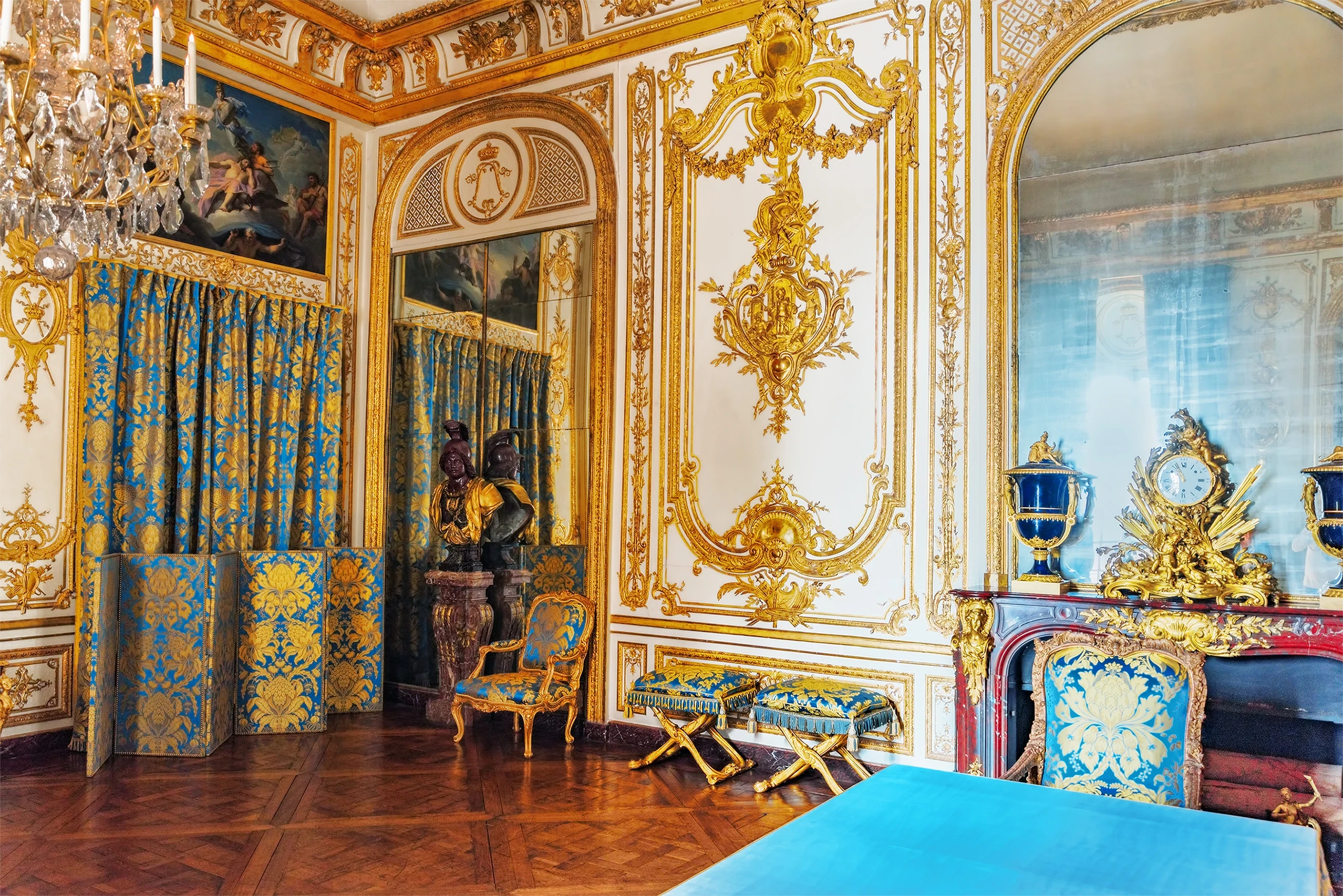 Le cabinet du Conseil : detail / Photo by V_E/Shutterstock.com
Le cabinet du Conseil : detail / Photo by V_E/Shutterstock.com
11 The King's bedroom
This is the heart of the château. This is where the King slept (although Louis XV and Louis XVI only got up for ceremonial occasions, preferring warmer rooms in the smaller apartments). More than a bedroom, it's a ceremonial place where the king receives guests when he rises or goes to bed. You can only attend these moments if you're important to the court, or chosen by the king. For example, you need a"brevet de chaise d'affaire" to be present when the king relieves himself. This is also where the king dines in public .
The King's bedroom / Gabriela Beres/Shutterstock.com No one could pass through the ballustrades unless authorized by Etiquette.
It was here that Louis XIV died on September 1, 1715 at the age of 76. It's also where he underwent the famous operation to remove an anal fistula. A very dangerous operation at the time, it was repeated on indigents (many of whom died) by the king's physician Charles François Felix. The king didn't scream. He just said "mon dieu" at one point. With the operation successful and the King's life saved, several "Te deums" were sung throughout France, including a hymn of joy that, in the amazing ways of history, became... "God save the King" the British national song.
King's bedroom photo by VICTOR TORRES/Shutterstock.com
If you turn your head, you'll see the balcony and the marble courtyard. You'll remember Marie Antoinette, stepping out onto the balcony, as the people of Paris, armed, shouted "la reine au balcon", and the heads of the château guards were held aloft on pikes. The Queen came out and bowed to the crowd, who finally applauded her.
Louis XV slept there on his arrival at Versailles, but it was so cold that he had a second fireplace added, before giving up on sleeping there and having a room built for himself a few meters away, from which he would leave in the morning to perform the rising ceremony in the king's bedroom and, in the evening, the bedtime ceremony.
Protocol demanded that we uncover ourselves and bow before the king's bed, even when he wasn't there.
12 l'antechambre de l'oeil de boeuf
It takes its name from the bull's eye that illuminates it. This is where courtiers waited to be called into the King's Chamber.
13 Le salon de la Paix
The opposite of the Salon de la Guerre, it is at the far end of the Galerie des Glaces. Part of the Queen's apartments, it was separated from them by a removable partition that was (rarely) removed for special occasions. It was here that Queen Marie indulged in one of her rare pastimes: gambling. In the center of the ceiling: France gives Peace to Europe. Above the mantelpiece, a portrait of King Louis XV.
14 The Queen's bedroom
The Queen's bedroom at Versailles. The bed, the piece of furniture on the left is the jewel-holder which contained Queen Marie Antoinette's jewels. walter_g/Shutterstock.com
This has always been the Queen's room. It was here that Maria Theresa of Austria slept (and died), as well as Queen Maria Lezczinska (who wouldn't have recognized the place, since her successor remodeled it).
Queen Marie-Antoinette by Elisabeth Vigée-Lebrun
This is where Marie Antoinette slept, and where she had everything refurnished. Here we discover the "Duchess bed" , whose canopy is adorned with the eagles of the House of Austria. On the side of the bed, to the left, is a concealed door. It was through this door that Marie Antoinette fled when the people of Paris stormed the château on October 6, 1789.
The Queen's bedroom at Versailles. the Bed. The ballustrade separated the Queen and authorized ladies from the rest of the court. This is where Marie Antoinette gave birth in public. It was so crowded that Louis XVI had to push the courtiers to break a pane and open the window. V_E.Shutterstock.com
It was also here that the queens of France gave birth in public, so that people could testify that the child born was indeed a son or daughter of France. 20 "enfants de France" were born here, including the future Louis XV, Louis XVI, Louis XVIII and Charles X.
Queen's bed / Detail Photo by Sophie Louisnard on Unsplash
15 Le salon des nobles / Noble's Salon
This was the room used as an antechamber by the queens of France. They were expected here. They also received guests here. The Queen's body was displayed here at the moment of her death.
Salon des nobles at the Château de Versailles Gabriela Beres/Shutterstock.com
16 Antechamber of the Grand Couvert de la Reine
In a way, it's the royal couple's dining room . They dine here in public. A spectacle. An orchestra plays music, everyone stands, and the King and Queen dine. Louis XIV and Louis XVI have ferocious appetites. They were served several dishes at the same time, and took what they liked. Sometimes they have to wait, especially for a drink, since it's a privilege to serve them. So you have to wait for a whole series of people to intervene, and you can't do otherwise, because it's an honor and they've often paid for it. This is where the wine froze in King Louis XIV's glass during the terrible winter of 1709, which did not spare Versailles (the Seine was frozen from Paris to its mouth, and the trees literally burst from the frost).
17 salle des gardes de la Reine
This is the room where the 12 bodyguards watched over the Queen. Many of them were killed during the days of October 1789, when they tried to prevent the people of Paris from entering the Queen's bedroom. The décor is entirely from the reign of Louis XIV. You can see what visitors saw over 3 centuries ago.
Furniture at the Château de Versailles walter_g/Shutterstock.com
Château de Versailles: discover the apartments of the Dauphin and the daughters of Louis XV
If you have time, visit the apartments of the dauphin and the daughters of Louis XV. 30 minutes for one, 45 minutes for the other. You'll discover all the delicacy of the "Siècle des Lumières" art of living.
Louis, Dauphin of France (1729 - 1765)
1 The Dauphin's library :
Made for Louis XV's son, the Dauphin (1729-1765). It is decorated with beautiful marine paintings. He loved playing music with his sisters. Louis XV's children were cultivated and gifted in the arts.
The Dolphin Library / Photo by Henri Lajarrige Lombard on Unsplash
2 Le cabinet du dauphin
Originally the bedroom and study of Monsieur, Louis XIV's brother, the two rooms were combined into one in 1693, and redecorated in 1747.
3 The Dauphin's bedroom
Originally the gilded study of Monsieur, the king's brother, and the study of the Regent, who died here in 1723, it was redecorated by the architect Gabriel (responsible for the magnificent Versailles opera house and the Place de la Concorde in Paris, among others) in the color green, a color thought to be good for sleep.
4 The Dauphin's second antechamber
It's a gallery of family portraits. It's a moving one, since most of the people portrayed here lived in this room and in Versailles.
Versailles: visit the apartments of "Mesdames", daughters of Louis XV
Madame Victoire / By Jean Marc Nattier in 1760.
Nicknamed"Mesdames", some of King Louis XV's unmarried daughters lived here. Louis XV and his wife, Queen Marie, had 10 children .
1 The lower gallery
It is located under the Hall of Mirrors
2 Madame Victoire's first antechamber
This is the waiting room for the king's daughter. There are a few chairs. Originally, it was Louis XIV's bathing room (he made little use of it).
3 Madame Victoire's second antechamber
This is the room where the princess entertains, in particular those newly admitted to the "honors of the court". Above the doors you can see the fables of La Fontaine .
4 Grand Cabinet de Madame Victoire
The room where music was king. The princess was a master of the harp, for example. It was to her that Mozart (who was received at Versailles and sat on Queen Marie's lap) dedicated sonatas for harpsichord, an instrument she also mastered perfectly.
5 Madame Victoire's bedroom
Magnificent rocaille-style bedroom with bed and furniture to adorn the princess when she wakes up.
Madame Victoire's bed Photo by Finn on Unsplash
6 Madame Victoire's interior cabinet
Her "own" room , the place was reserved for her. In a palace where everything was public, it was the only room where the princess could retreat to meet the people of her choice. The Versailles of today is not so different from the Versailles of the Court, since many visitors, not all of them noble, could be found here. All you had to do to enter the estate was hire a sword at the entrance, in keeping with the ancient tradition of allowing his subjects to approach the King of France. One could even send him requests, in written form known as "placets". The crowds led to a number of inconveniences, not least theft, of which even King Louis XIV was a victim. There were already pickpockets.
7 Madame Victoire's library
Which she shared with Madame Adélaide, her sister. To recognize their books, they were bound in different colors. Green for one, red for the other.
8 Madame Adélaïde's interior cabinet
Before being given to Louis XV's daughter, this room was part of the apartment of the Marquise de Pompadour, Louis XV's royal mistress, who entertained here. She died here in 1764.
Marie Adélaïde de France, known as Madame Adélaïde (1732-1800), daughter of Louis XV and Marie Leszczinska / Source Monsieurdefrance.Com: Wikicommons
9 Madame Adélaïde's room
With its woven decor. There were two types: one for summer, the other for winter, and the one shown here is the "summer furniture". Note the Riesner commodes, named after the great cabinetmaker who also designed Louis XV's sublime bureau.
How do I visit the Parc du Château de Versailles?
Garden and Château de Versailles / photo Vivvi Smak/Shutterstock.com
It's impossible to imagine Versailles without its park. In fact, the park was developed before the château. Louis XIV wanted it to be a place for festivities. Most of it was designed by André Le Nôtre. It's important to distinguish between the park and the gardens, which are not necessarily the same thing. The gardens stretch out in front of the château. To sum up, these are the areas of pruned boxwood that run from the château to the Grand Canal. Beyond that, we're talking about the Parc de Versailles (with its many trees and the two Trianons).
Our advice: take good shoes and enjoy walking. It's a long way around the gardens of Versailles and Trianon. Don't hesitate to get lost on purpose, as it's quite easy to find your way around: the gardens are made up of squares side by side, and in each of these squares there's an artistic surprise. Never forget a small umbrella, as the weather changes quickly in Versailles...
The Latone Basin
The Latone Basin / Image by 365 Focus Photography/Shutterstock.com
Start by going to the end of the esplanade, and you'll see the splendid Latone Basin. Round, it features the mother goddess of Apollo and Diana at the very top, surrounded by 20 frogs and 24 turtles and lizards (the Lycian peasants who mocked Latona for turning them into frogs).
The Appolon Fountain / Image by Mistervlad/Shutterstock.com
Le Parterre du Midi / the Grand Canal and groves
Then turn left and head downhill. You'll find the parterre du midi, below which is the parterre de l'Orangerie , and in the distance you'll see the pièce d'eau des Suisses. You're above the orangerie, a great luxury in Louis XIV's time, as it provided shelter for trees such as orange and lemon trees, which do not do well in the climate of northern France.
Parterre de l'orangerie et pièce d'eau des suisses / Image by Artem Avetisyan/Shutterstock
Go down the steps (you'll see the orangery on your left) and at the bottom turn right to enter the gardens. Above all, get lost. You'll discover "bosquets" or decorated areas, sometimes laid out like scenes, and that's the charm of the gardens at Versailles. We recommend that you walk along the esplanade and take the second alley on your left. At one point, on your left, you'll see the bosquet de la Reine (Queen's grove). Go and have a look at it, then return to the main alley and go to your right, where you'll come across the "bosquet de la salle de bal" (ballroom grove ) with its astonishing shape, its water jets, its "shells" (which make a lovely noise when the water flows) and its Langedoc marble. Then return to the same alley, and at the second round pool, turn diagonally right to discover the magnificent Colonnade grove. You'll then reach the Grand Canal, a vast expanse of water on which Louis XIV loved to let gondolas glide, and you'll have a double perspective, one on the Grand Canal and the other on the Bassin de Latone and the Château.
The Grand Canal / Domaine de Versailles / Image by Vladimir Osipov/Shutterstock
If you're in a hurry and not going to Trianon :
If you want to save time, cross the main alley, leaving the Grand Canal on your left, then turn right and walk up to the château via one of the alleys on the left coming from the Grand Canal. At one point you'll pass the sublime bosquet known as "des bains d'appolon". Here, Apollo (god of the sun), whom the sculptor has given the features of Louis XIV, is bathed by nymphs after his day's work. Finally, head back up towards the château to discover the Parterre Nord with its drawings and waterfalls, and arrive at the esplanade.
The parterres of the French garden, a springtime delight / Image by Smokedsalmon/Shutterstock
If you go to Trianon :
When you're at the Grand Canal, with the château behind you, take the long driveway on your right. At one point you'll turn left, and at the end of the driveway you'll discover the Grand Trianon , after skirting the walls of the Petit Trianon. It's well worth the detour.
Versailles: visit the Grand Trianon
The facades of the Grand Trianon / Image by Mistervlad/shutterstock
It was Louis XIV's place of pleasure, where he relaxed a little from the constraints of his "profession". Built by Jules Hardouin Mansard, Louis XIV's architect, it was completed in 1683. The residence of the Republic, which can accommodate prestigious guests (Queen Elizabeth II has slept here), it was also the residence of Emperor Napoleon I and a favorite of Eugénie de Montijo, wife of Emperor Napoleon III. At Trianon, you'll discover 3 centuries of decorative history , furniture and, of course, the history of France. The very Italian colonnades and the garden are enchanting.
Columns at the Grand Trianon / Photo andre quinou/Schutterstock.com
Versailles: visit the Petit Trianon
The Temple of Love in the gardens of the Petit Trianon / Image Jacky D/Schutterstock.com
A gift, to start with. The one Louis XV gave his mistress, the Comtesse du Barry, in 1769. Designed by the architect Gabriel, in the middle of a plant garden and not far from the menagerie (Versailles had long had its own zoo, open to the public, which included a rhinoceros), the estate was offered by Louis XVI to his wife Marie Antoinette, who made it her private and privileged place.
La Comtesse du Barry in "flore" by François-Hubert Drouais (1769) Château de Versailles collections
By Jean-Pol GRANDMONT - Own work, CC BY 4.0, https://commons.wikimedia.org/w/index.php?curid=94865171
Eager for tranquility, she couldn't stand "Etiquette" (the protocol of Versailles), so she had her apartments fitted out, invited her friends, and didn't hesitate to have the windows obscured so that no one could see her. An ingenious system uses pulleys to pull out mirrors that conceal the exterior while "virtually" enlarging the interior.
Le petit Trianon / Image Pack-Shot/Schutterstock.com
This is one of the prettiest places in Versailles. A delicate place, imbued with the art of living of the aristocracy of the Age of Enlightenment. You have to visit it at least once, especially as there are so many rooms to discover, and most of the tourists who enter the Hall of Mirrors don't make it that far. You might even find yourself alone and, who knows, bump into Marie Antoinette, as English tourists did in the 1900s. They described a woman and her children sitting peacefully on the grass, before a gentleman in a rolling wig came to announce that they had to return to the château because a large crowd was arriving at Versailles. They said they thought it was a re-enactment. Questioned several times, they never deviated, which is why some saythe Petit Trianon is a bit "haunted" or a corridor of time... So many mysteries!
Marie Antoinette and her children, by Elisabeth Vigée-Lebrun. They include the future "Madame Royale" Marie Thérèse (the Queen's eldest daughter), the first Dauphin (who died of tuberculosis in 1789), and the young Duke of Normandy (who became Dauphin and died in Temple Prison at the age of 12). The empty cradle refers to the absence of "Madame Sophie", the last child of Marie Antoinette and Louis XVI, who died as an infant very recently, when the painting was done by the Queen's official painter.
Trianon is home to Marie Antoinette's little theater (hard to find and hard to visit), designed by architect Richard Mique and inaugurated in 1780. It was here that the Queen indulged her passion for the theater, staging a few plays for her intimates. Louis XVI saw a few of them, and, very much in love with his wife, applauded every time. Many of the interiors simulate marble or gilding, when in fact they are made of papier-mâché and copper. It's quite astonishing.
The Temple of Love / Photo by Fabianodp/Schutterstock.com
You'll also discover the original French pavilion, set in the middle of the French garden pathways, and the cool pavilion (with its green trellis) where the Queen used to sit to drink fresh milk on hot summer days, Further on, on the way to the Queen's hamlet, you'll come across the moving Temple de l'Amour, with its columns and rounded roof above the water, and a copy of "Hercule taillant sa masse" by sculptor Bouchardon. Further on, towards the Queen's hamlet, you'll discover the English garden. Very poetic...
Versailles: visit the Queen's hamlet.
For once, we haven't invented anything: the 18th century had a passion for nature long before us. Marie-Antoinette succumbed to this fashion for country living by buying herself a "hameau ", just as her cousin-in-law Condé had done at Chantilly. Here we find a kind of ideal farm (for the time), inspired by Norman farms, where the queen came to see her chickens (which were sometimes served at the royal table), her cows, and had fruit and vegetables "brought in" to be served to her children, among others. In a way, she invented the short circuit from producer to consumer...
The Marlborough Tower and the Queen's Hamlet / Versailles / Image by Takashi Images
The Queen's hamlet includes a small lake, where people used to fish in small boats, and 11 houses, including the Queen's house (recently restored), the "laiterie de propreté" and the famous Marlborough tower. This is where Marie-Antoinette was taken when the Parisian crowd arrived in October 1789. Note the vegetable gardens around the small houses.
One of the Hameau de la Reine buildings POC/shutterstock.com
And back to the château via the Grand Canal
When you're at the top of the Grand Canal, with the château in front of you, don't take the main avenue, but the parallel one on your left. You'll come across the superb bosquet de l'Enclade and the bosquet de l'Obelisque. At one point you'll pass the sublime bosquet known as "des bains d'appolon". Here you can see Apollo (the sun god), whom the sculptor gave the features of Louis XIV, being bathed by nymphs after his day's work. Finally, you'll return to the château to discover the Parterre Nord, with its drawings and waterfalls, and arrive at the esplanade.
Several days at Versailles: what to see?
Versailles is so vast, with over 60,000 works signed by the greatest artists of the 17th and 18th centuries, that you could easily spend two days there. You'll want to take your time, because one day to visit the château, the park and the Trianons is pretty "speedy". And at Versailles, there are treasures that can only be discovered on guided tours. For example, the King's study, recently renovated, and one of the most beautiful pieces of French furniture in history, Louis XVI's library or Madame du Barry's apartment... Another must-see is the Opéra, long the largest and most modern opera house in Europe. Inaugurated for the wedding of Louis XVI (then Duc de Berry) and Marie-Antoinette, it is sumptuous.
Click here for themed guided tours.
There are many ways to discover the Versailles estate. On reservation, you can visit Madame du Barry's apartments (on the 2nd floor), the King's small apartments (including the magnificent bueau) and the Versailles Opera House, pictured here by Isogood_patrick/shutterstock.com.
3 places to see near the Château de Versailles
1 The carriage gallery
The carriage gallery is located in the King's Grandes Ecuries at Versailles / Photo by UlyssePixel/Shutterstock
Located just opposite the château, in the grand écurie, the exhibition features some of the carriages that carried us through the great moments of French history. Napoleon 1st's wedding coach, Charles X's coronation coach... A collection born of the will of Louis Philippe, King of the French. One of the carriages is very moving. It's the wheelchair of Louis Joseph, the first dauphin, son of Louis XVI and Marie Antoinette. Born in 1781, he died of a long illness in 1789, on the eve of the Estates-General that marked the start of the French Revolution.
2 The king's kitchen garden
An astonishing garden created by Monsieur de la Quintinie to supply the Court and above all the King's table with fruit and vegetables. A French-style "square" garden, in which the gardener succeeded in growing the peas that Louis XIV adored, and which the Court made the fashionable vegetable. It was also here that the espalier technique was invented for pears. It's also the birthplace of mushrooms. A must-see for those who love botany. In fact, horticultural training courses are given here.
Admission is 5 euros. Like all Versailles gardens, it is closed on Mondays. January to October 10am-6pm. November to December 10am-5pm and Saturday 10am-1pm. The website is here
Tulips were very fashionable under Louis XIV. They were even the cause of the first financial crisis in modern history: the tulip crisis. Prices rose so fast that buyers were snapping up bulbs before they even existed. When the fad faded, prices collapsed and fortunes fell with them. Photo by Claude Laprise on Unsplash
3 the city of Versailles :
The administrative capital of France for over 100 years, Versailles retains its magnificent streets, with numerous hôtels particuliers. You'll find some nice little restaurants on the right as you leave the château, and not far from the estate is the antiques district. The Rocaille-style Cathedral of Notre Dame, completed in 1754, is well worth a visit.
To find out more about tourism in Versailles, click here.
Château de Versailles / By night / younes_bkl/Shutterstock

